Slept so crap last night.. was asleep around 2230 and unfortunately was awake at 0330ish and even though I was thoroughly exhausted, I just could not get back to sleep… probably due to sharing a bed, the same being rock hard, or just that I was in shite tonnes of pain (or a combination thereof), but I slept like crap. Tossed and turned for what felt like a few hours and eventually dozed back off, only to be woken by the call to prayer going out over Moulay Idriss at 0621. So much for that 0700 alarm. We got our act together, packed our bags and went down to have some breakfast before heading to off to see the anicient Roman ruins of Volubilis which was about ten minutes away.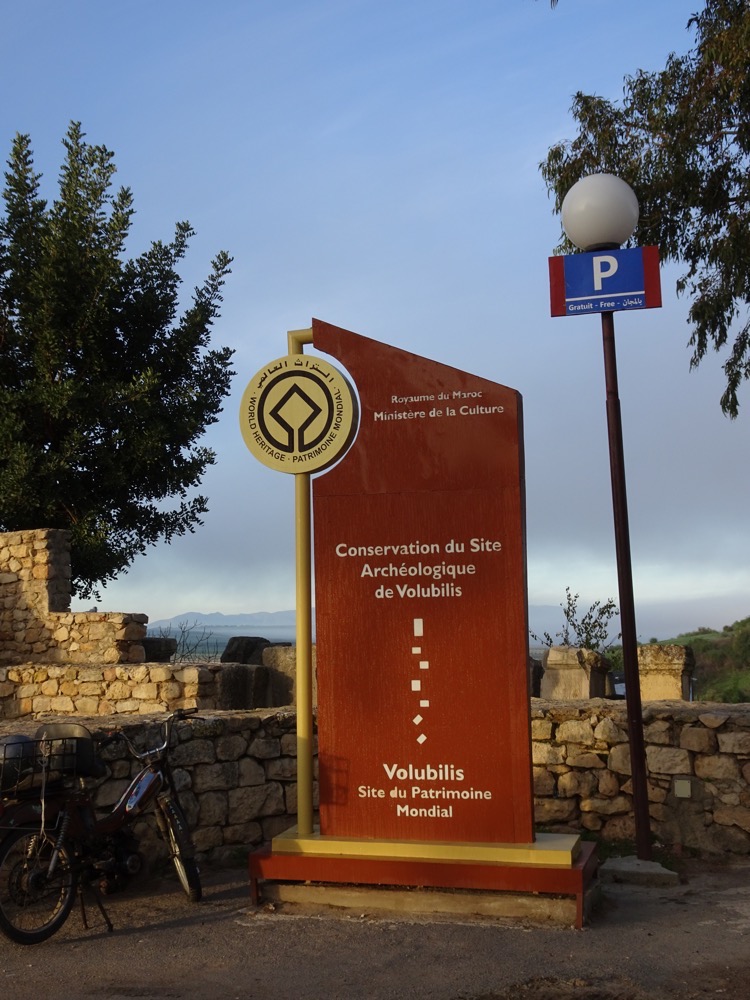 Volubilis is a partly excavated Roman city not far from Meknes – it is commonly referred to as the anicient capital of the kingdom of Mauretania. It was apparently settled around 200BC and built using slave labor obtained from the local Berber population.
Volubilis is a partly excavated Roman city not far from Meknes – it is commonly referred to as the anicient capital of the kingdom of Mauretania. It was apparently settled around 200BC and built using slave labor obtained from the local Berber population. 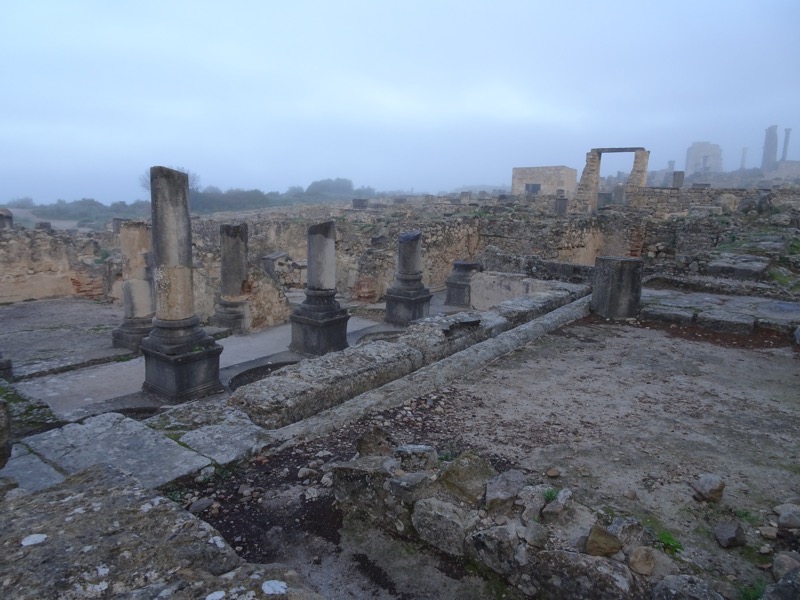 The town grew rapidly under Roman rule – they really know how to build – from about the 1stC AD onwards and became a town of about 10,000 people that covered about 100 acres contained in roughly 2.5kms of city walls. The city had quite a few large public buildings by 200AD, including a basilica, a temple complete with animal sacrifice altars and triumphal arch. The town owed much of its wealth and prosperity to their olive industry which enabled an upper class of patrons to indulge in building fancy town-houses with fabulously large and ornate mosaic floors-many of which have been quite well preserved.
The town grew rapidly under Roman rule – they really know how to build – from about the 1stC AD onwards and became a town of about 10,000 people that covered about 100 acres contained in roughly 2.5kms of city walls. The city had quite a few large public buildings by 200AD, including a basilica, a temple complete with animal sacrifice altars and triumphal arch. The town owed much of its wealth and prosperity to their olive industry which enabled an upper class of patrons to indulge in building fancy town-houses with fabulously large and ornate mosaic floors-many of which have been quite well preserved.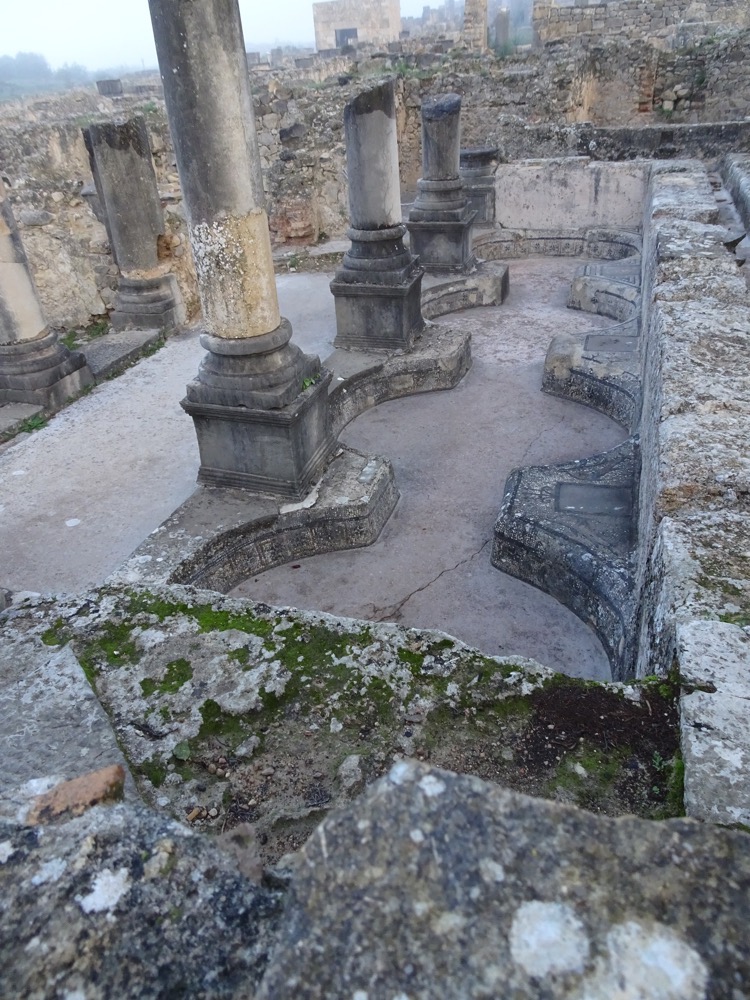
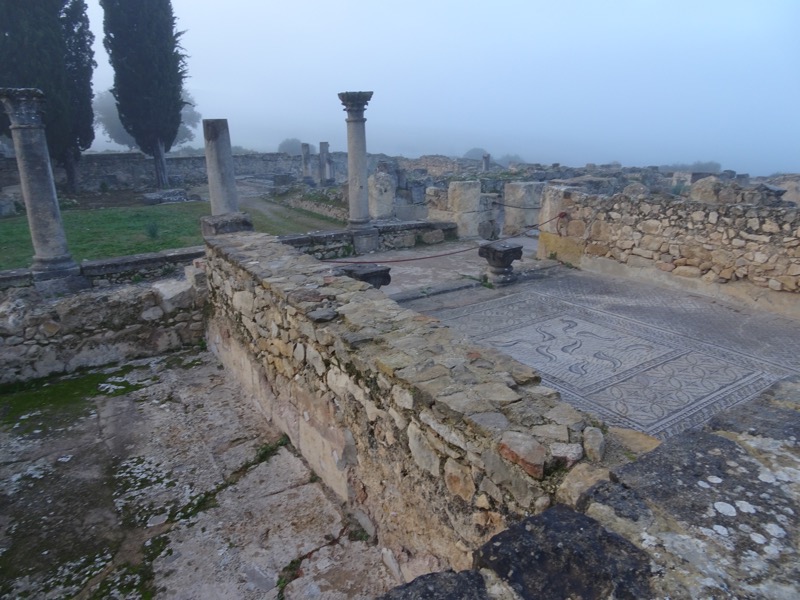 A terrace that would have been an open courtyard for dining with lovely dolphins in the mosaic floors.
A terrace that would have been an open courtyard for dining with lovely dolphins in the mosaic floors.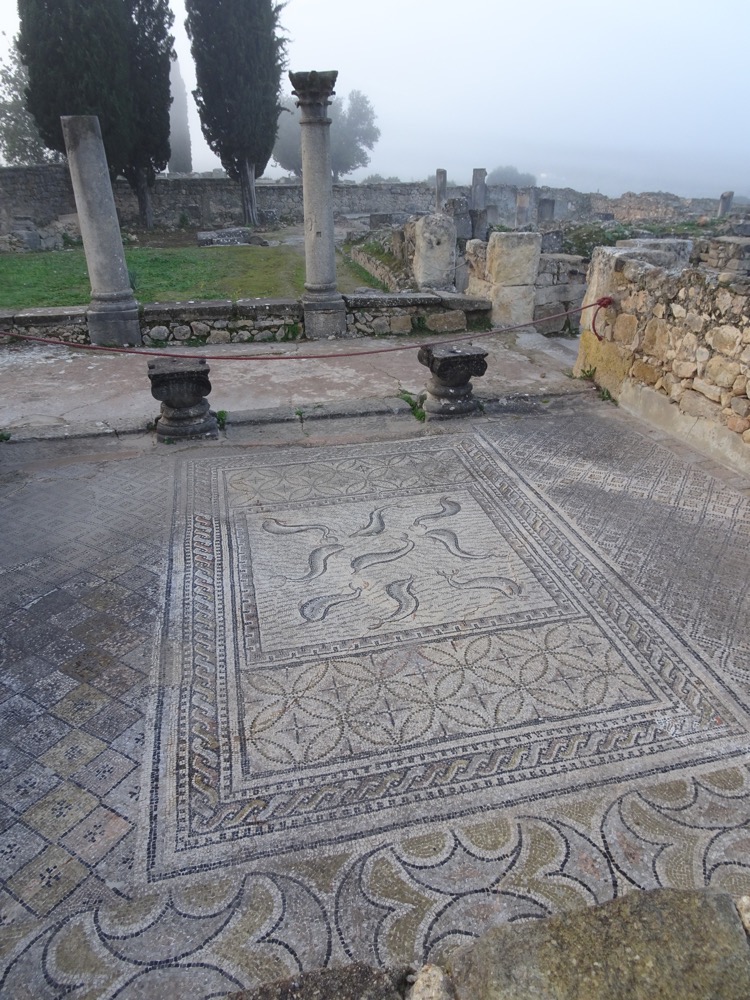
Orpheus’ House – contained an enormous mosaic depicting Orpheus surrounded by exotic animals from Africa. 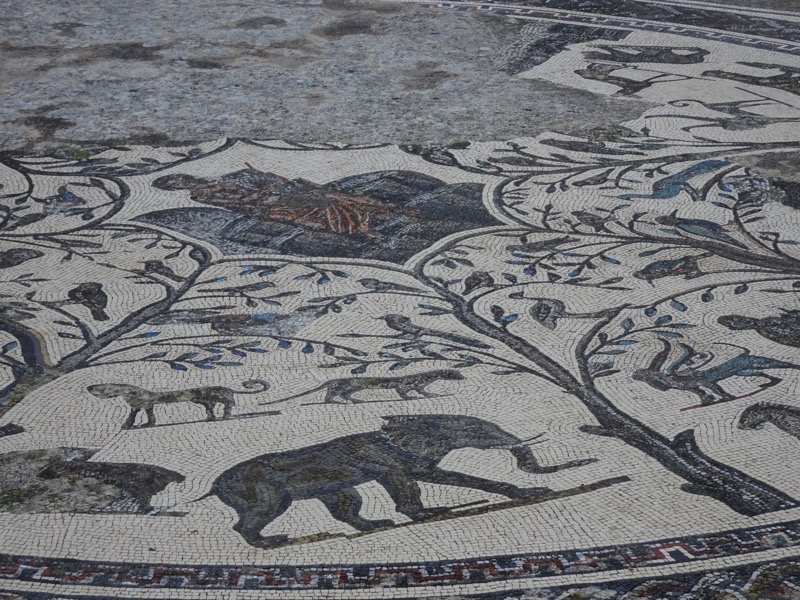
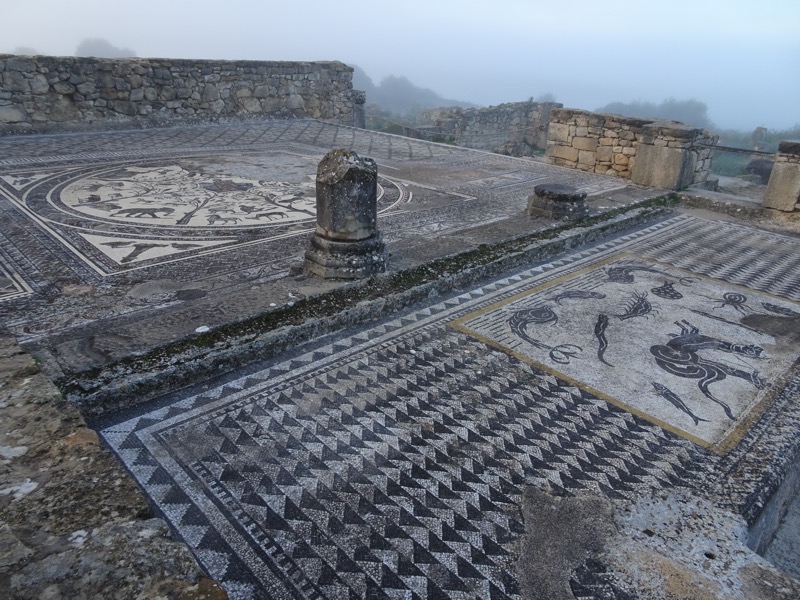 The city eventually fell along when the entire Roman Empire did around 285AD. It was never reclaimed by Rome due to remote location and the Empire’s inability to defend their south-west borders. The Berbers who built the town as slaves came to inhabit the town for the following 700 years – initially as a Latin/Christian community, before it became an early Islamic settlement. Roughtly by 1000AD, Volubilis was abandoned as the state power was relocated to nearby Fes. Quite a lot of the local Berber population moved to Moulay Idriss Zerhoun where we stayed last night.
The city eventually fell along when the entire Roman Empire did around 285AD. It was never reclaimed by Rome due to remote location and the Empire’s inability to defend their south-west borders. The Berbers who built the town as slaves came to inhabit the town for the following 700 years – initially as a Latin/Christian community, before it became an early Islamic settlement. Roughtly by 1000AD, Volubilis was abandoned as the state power was relocated to nearby Fes. Quite a lot of the local Berber population moved to Moulay Idriss Zerhoun where we stayed last night.
No visit to acient Roman ruins would be complete without a guide obligingly telling you where the latrines were and how the water systems worked: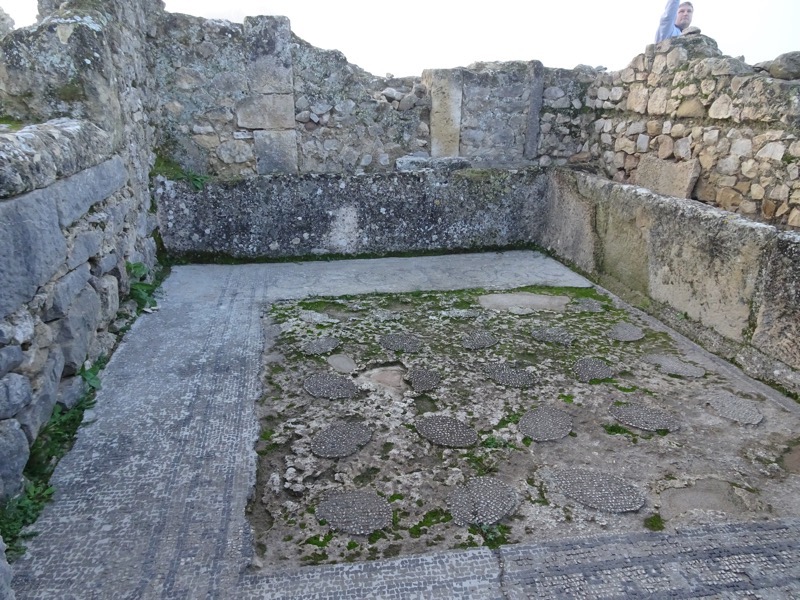 Being made of natural stone rather than ceramic, the mosaics are in incredible condition given their age and the disruptions to the civilization here.
Being made of natural stone rather than ceramic, the mosaics are in incredible condition given their age and the disruptions to the civilization here. 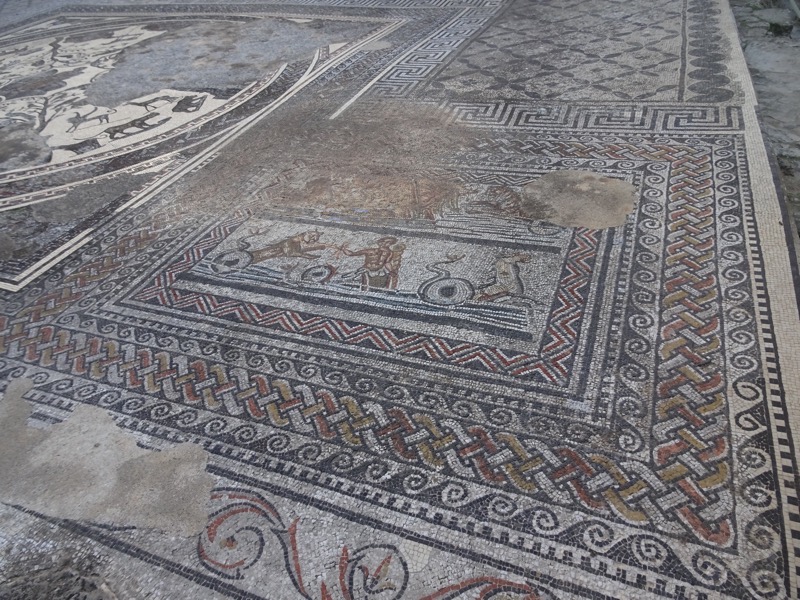 A reconstructed olive press that shows how the town made much of its wealth:
A reconstructed olive press that shows how the town made much of its wealth: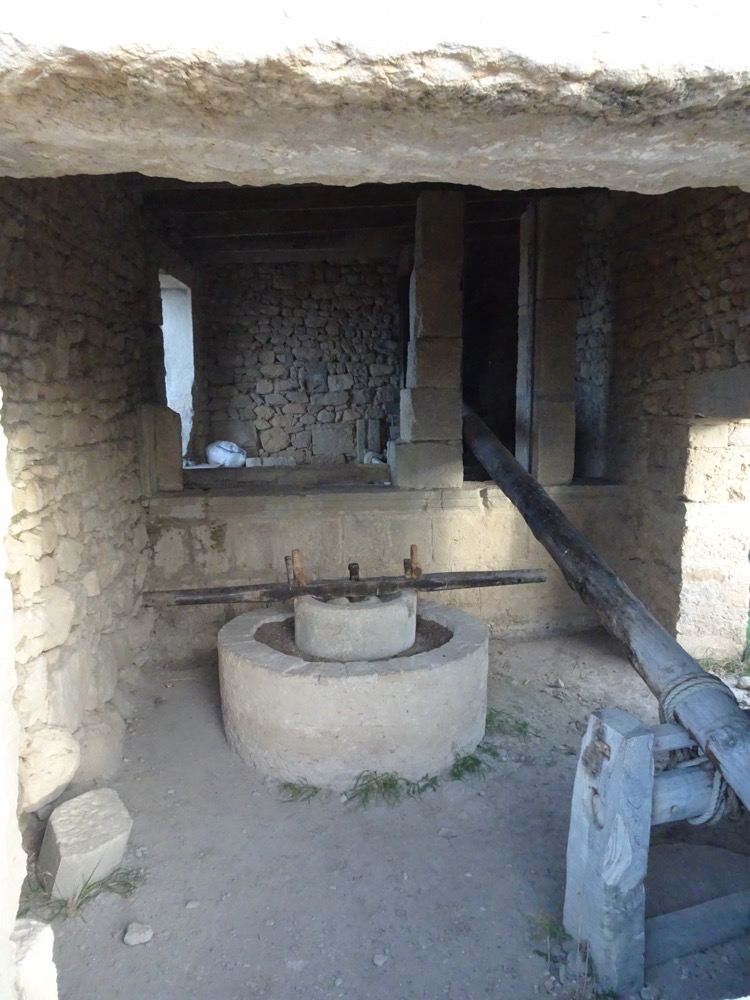 We arrived at the site very early and were the first visitors, so we had the place predominantly to ourselves… there was a very moody early morning fog that lifted about half an hour after we arrived.
We arrived at the site very early and were the first visitors, so we had the place predominantly to ourselves… there was a very moody early morning fog that lifted about half an hour after we arrived.
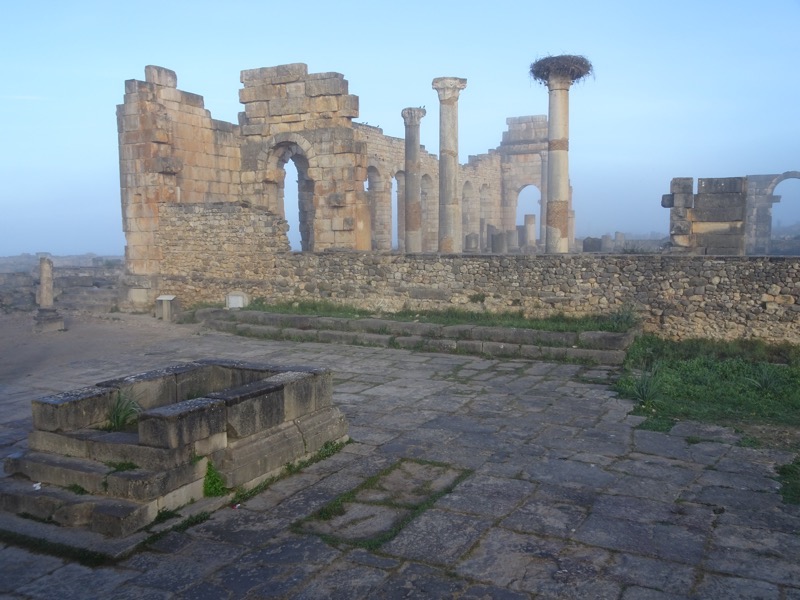 (above) Sacrificial altar out front of the Capitiline Temple looking towards the Basilica.
(above) Sacrificial altar out front of the Capitiline Temple looking towards the Basilica.
(below) A view of the Basilica from behind the main facade
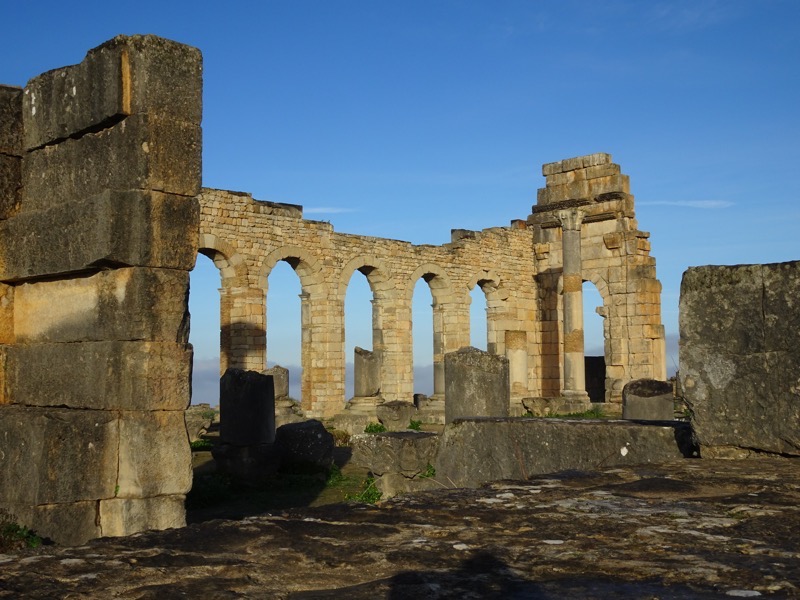 The tops of ancient columns seem to be a favoured place for swallows and storks to build their nests…
The tops of ancient columns seem to be a favoured place for swallows and storks to build their nests…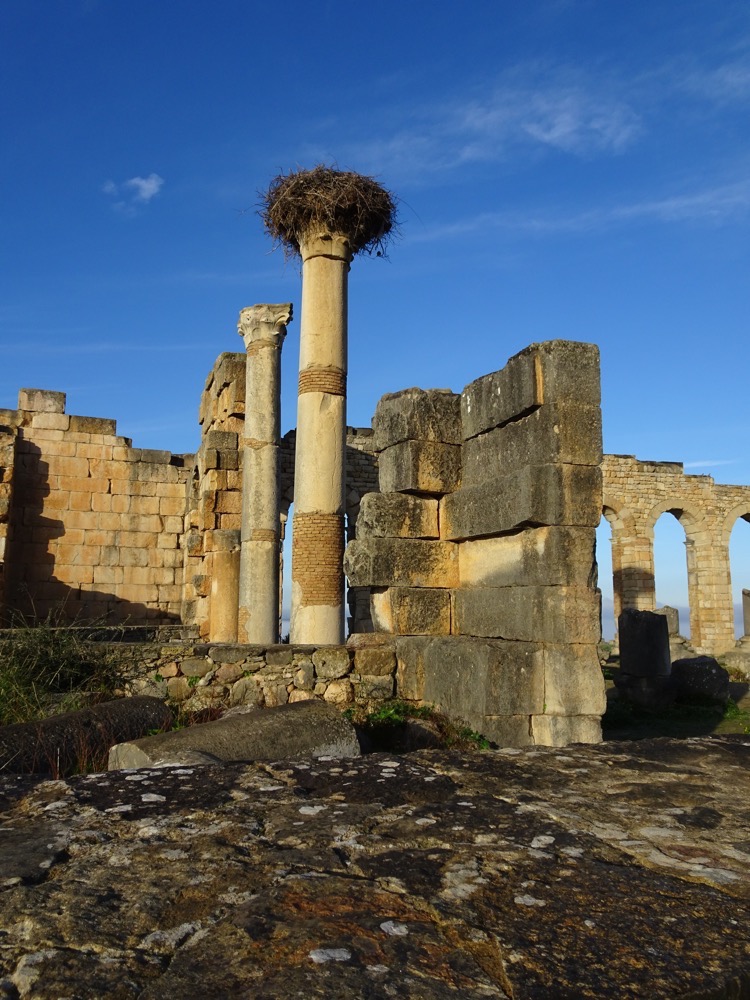 Front facade of the Basilica
Front facade of the Basilica 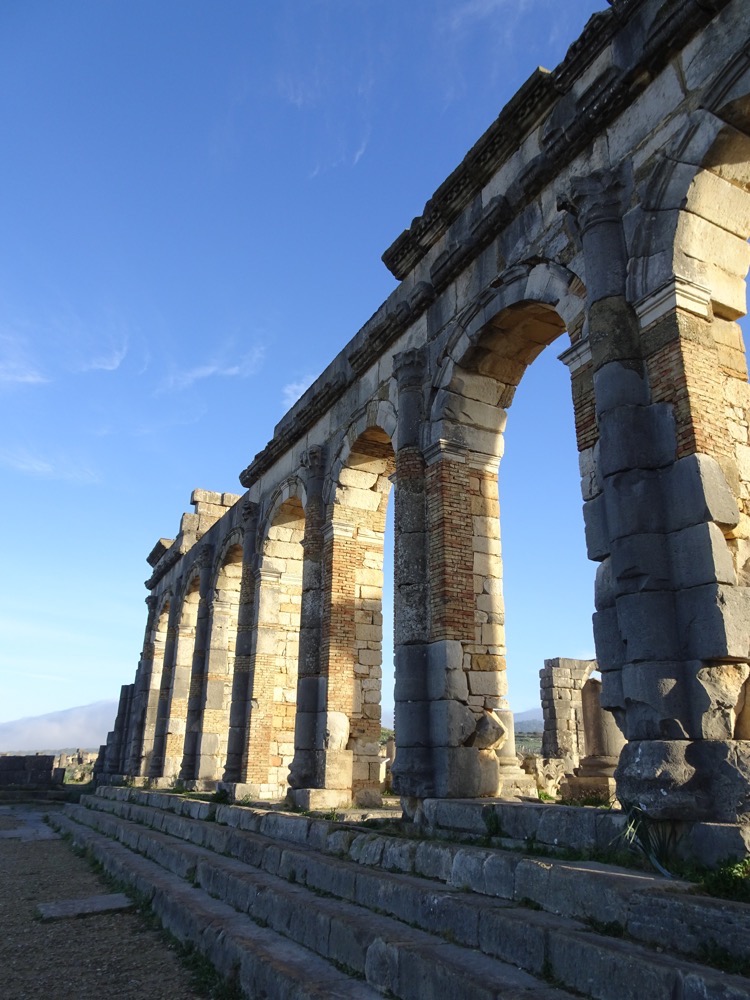 The town, while overrun with wilderness and dissued, remained substantially intact until they a devastating earthquake in the 1700s that tore through Lisborn down into North Africa. It was not long after this that the site was plunders by various local Moroccan rulers for stone to use in the building of nearby Meknes. It was then another century before the site was definitively identified as the ancient city of Volubilis.
The town, while overrun with wilderness and dissued, remained substantially intact until they a devastating earthquake in the 1700s that tore through Lisborn down into North Africa. It was not long after this that the site was plunders by various local Moroccan rulers for stone to use in the building of nearby Meknes. It was then another century before the site was definitively identified as the ancient city of Volubilis.
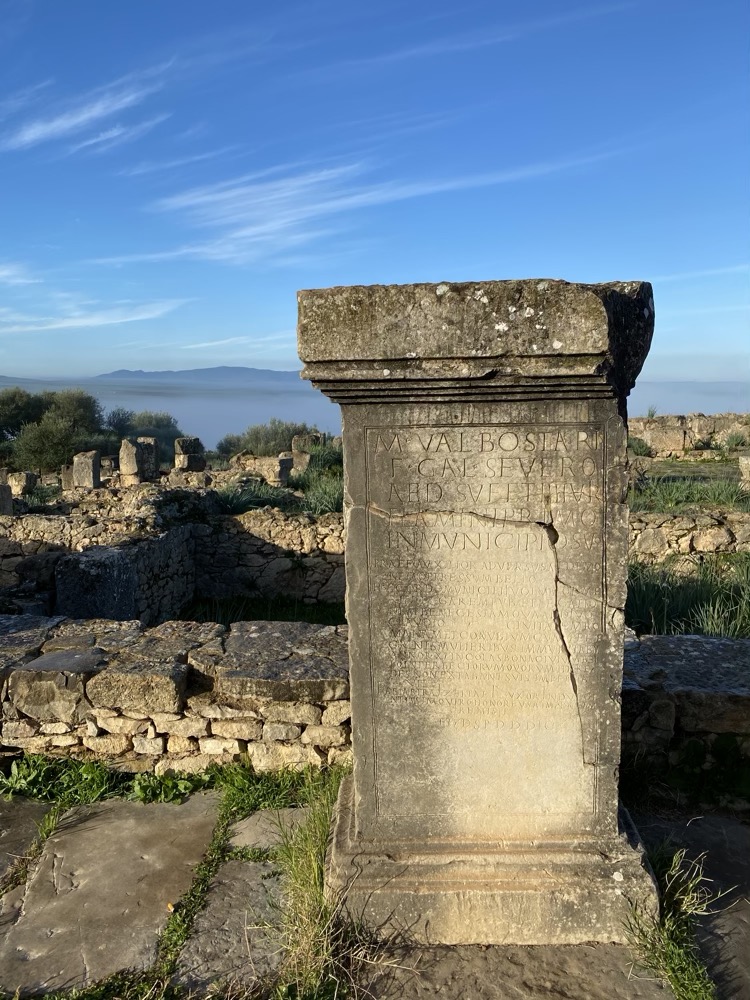 Interior of the Basilica
Interior of the Basilica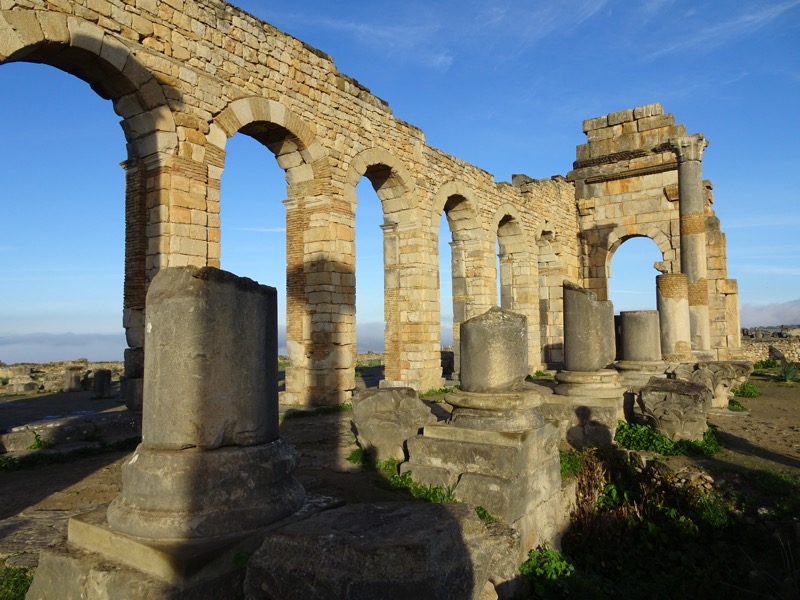 Captioline Temple
Captioline Temple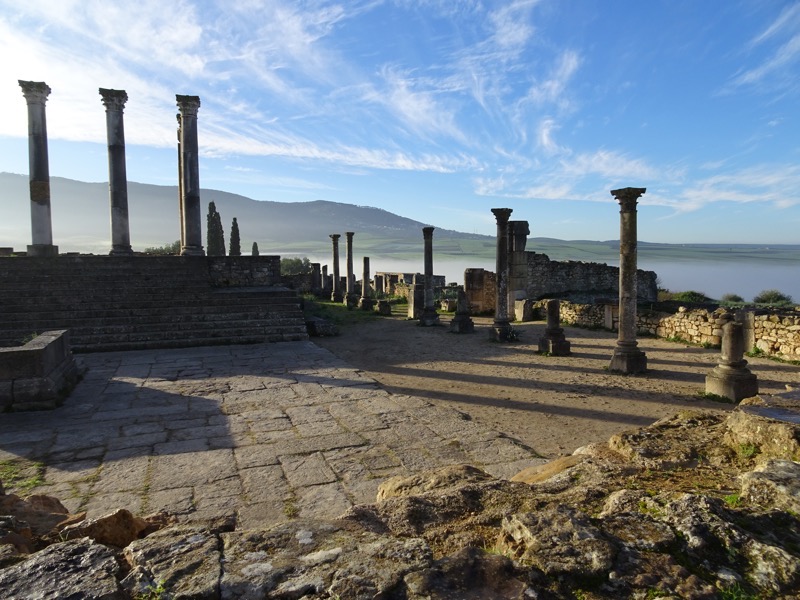 When the French were exercising colonial rule over Morocco, roughly half the town was excavated, which is when the amazing mosaics were discovered, along with several of the public buildings and obviously wealthy homes. Today it is another one of those cool UNESCO World Heritage Sites, having been listed as “an exceptionally well-preserved example of a large Roman colonial town on the fringes of the Empire”.
When the French were exercising colonial rule over Morocco, roughly half the town was excavated, which is when the amazing mosaics were discovered, along with several of the public buildings and obviously wealthy homes. Today it is another one of those cool UNESCO World Heritage Sites, having been listed as “an exceptionally well-preserved example of a large Roman colonial town on the fringes of the Empire”.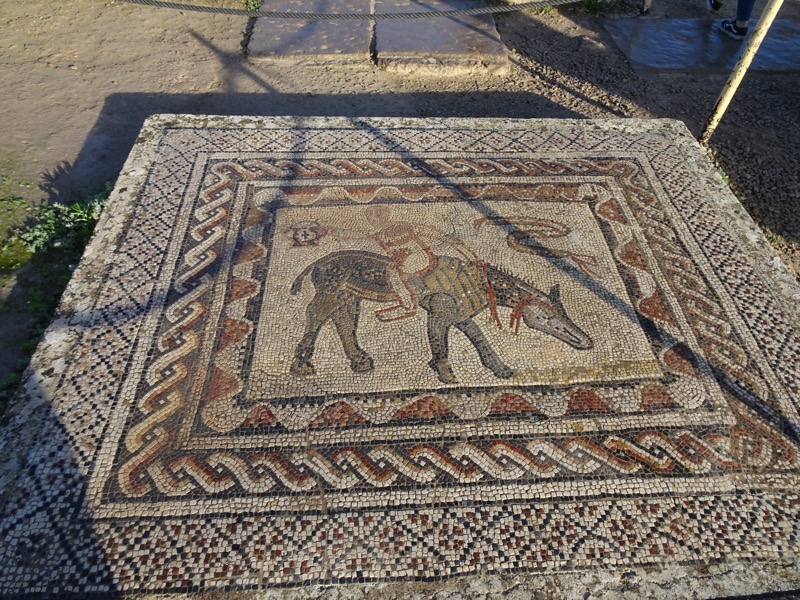 Arch of Caracalla (Triumphal Arch) – one of the coolest thigns about this arch is that it faces directly towards Rome. They also know quite a bit about what it would have originally looked like, thanks to the inscription on the stone itself… six large bronze horses used to adorn this archt
Arch of Caracalla (Triumphal Arch) – one of the coolest thigns about this arch is that it faces directly towards Rome. They also know quite a bit about what it would have originally looked like, thanks to the inscription on the stone itself… six large bronze horses used to adorn this archt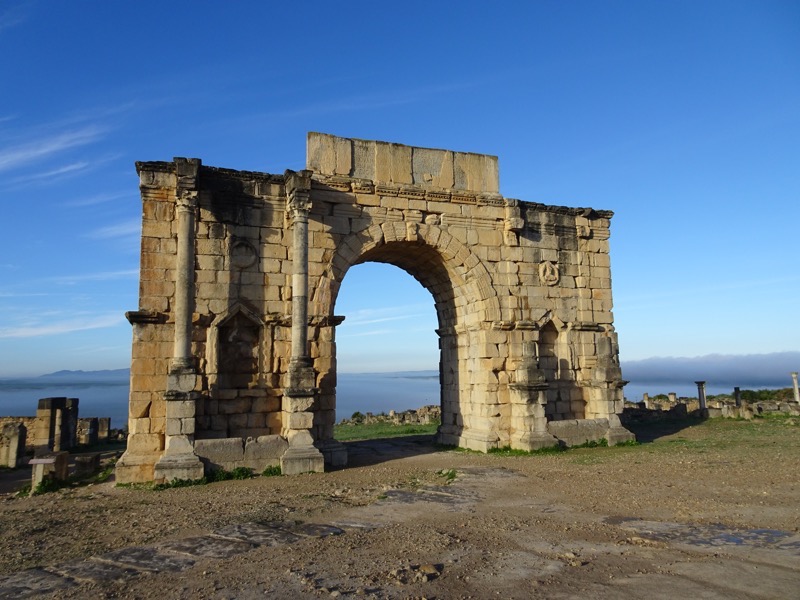
The inscription reads (after the abbreviations have been expanded):
IMPERATORI CAESARI MARCO AVRELLIO ANTONINO PIO FELICI AVGVSTO PARTHICO MAXIMO BRITTANICO MAXIMO GERMANICO MAXIMO PONTIFICI MAXIMO TRIBVNITIA POTESTATE XX IMPERATORI IIII CONSVLI IIII PATRI PATRIAE PROCONSVLI ET IVLIAE AVGVSTAE PIAE FELICI MATRI AVGVSTI ET CASTRORVM ET SENATVS ET PATRIAE RESPVBLICA VOLVBILITANORVM OB SINGVLAREM EIVS ERGA VNIVERSOS ET NOVAM SVPRA OMNES RETRO PRINCIPES INDVLGENTIAM ARCVM CVM SEIVGIBVS ET ORNAMENTIS OMNIBVS INCOHANTE ET DEDICANTE MARCO AVRELLIO
SEBASTENO PROCVRATORE AVGVSTI DEVOTISSIMO NVMINI EIVS A SOLO FACIENDVM CVRAVIT
or, in translation:
For the emperor Caesar, Marcus Aurelius Antoninus [Caracalla], the pious, fortunate Augustus, greatest victor in Parthia, greatest victor in Britain, greatest victor in Germany, Pontifex Maximus, holding tribunician power for the twentieth time, Emperor for the fourth time, Consul for the fourth time, Father of the Country, Proconsul, and for Julia Augusta, the pious, fortunate mother of the camp and the Senate and the country, because of his exceptional and new kindness towards all, which is greater than that of the principes that came before, the Republic of the Volubilitans took care to have this arch made from the ground up, including a chariot drawn by six horses and all the ornaments, with Marcus Aurelius Sebastenus, procurator, who is most deeply devoted to the divinity of Augustus, initiating and dedicating it.
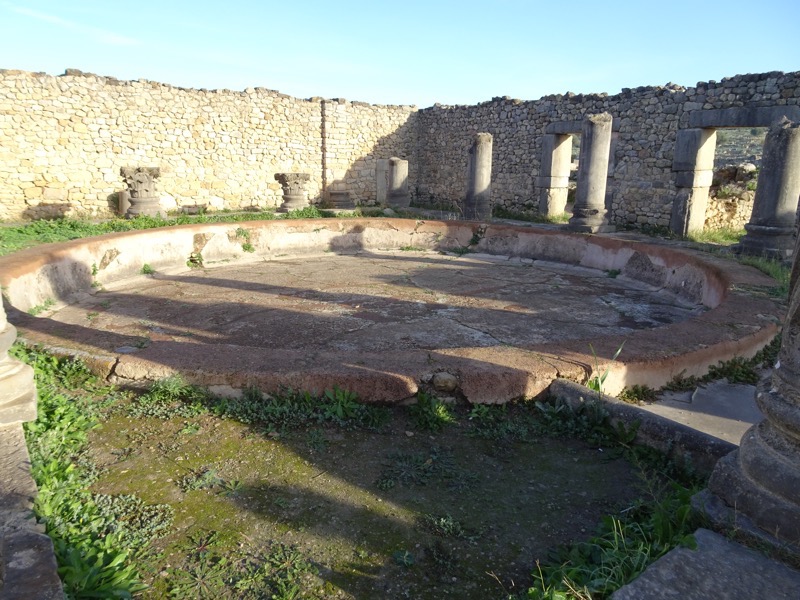
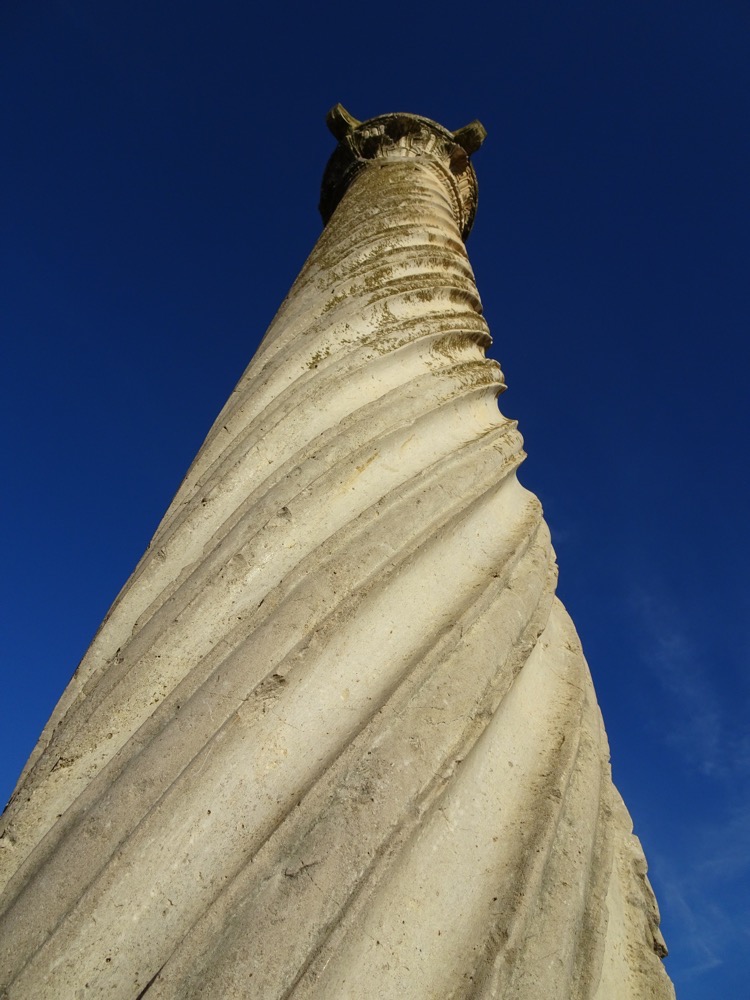 A somewhat damaged mosaic depicting the Goddess DIana… Diana herself has been removed from the mosaic, most likely by the French who took many artefacts from the site and sent them back to France.
A somewhat damaged mosaic depicting the Goddess DIana… Diana herself has been removed from the mosaic, most likely by the French who took many artefacts from the site and sent them back to France.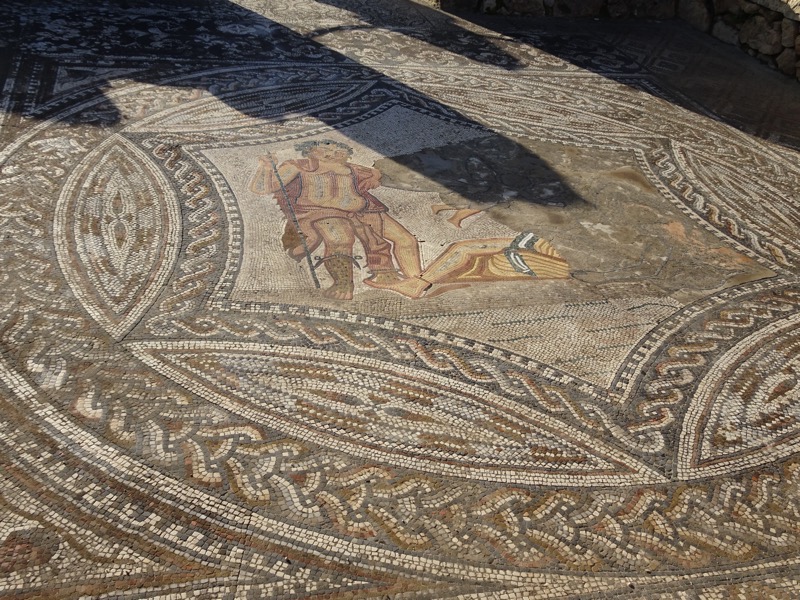 This wonderful, large terrace space depicts the Twelve Trials of Hercules.
This wonderful, large terrace space depicts the Twelve Trials of Hercules.
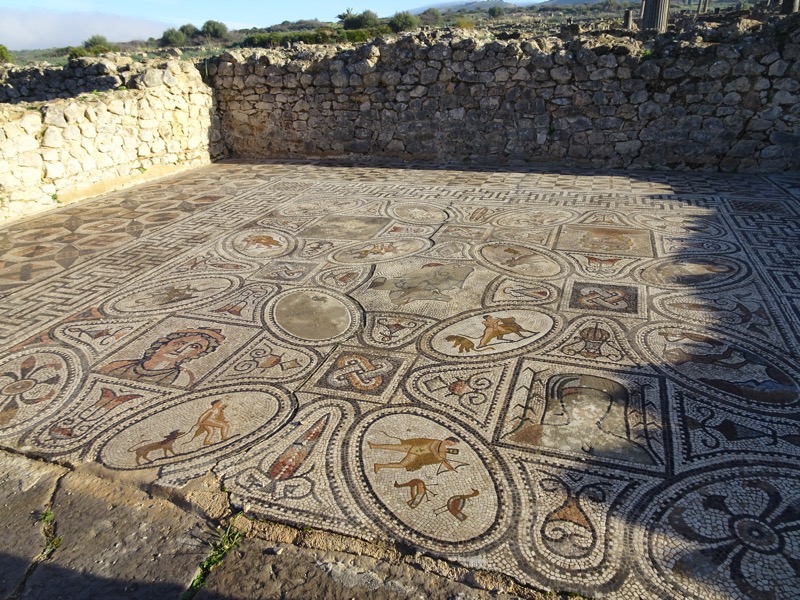
 Shooting lions, wrestling pheasants, that sort of thing…
Shooting lions, wrestling pheasants, that sort of thing… A spa area which had a fountain in the middle and visitors could sit in the semicircular cut out spaces and enjoy the fresh waters from the fountains.
A spa area which had a fountain in the middle and visitors could sit in the semicircular cut out spaces and enjoy the fresh waters from the fountains.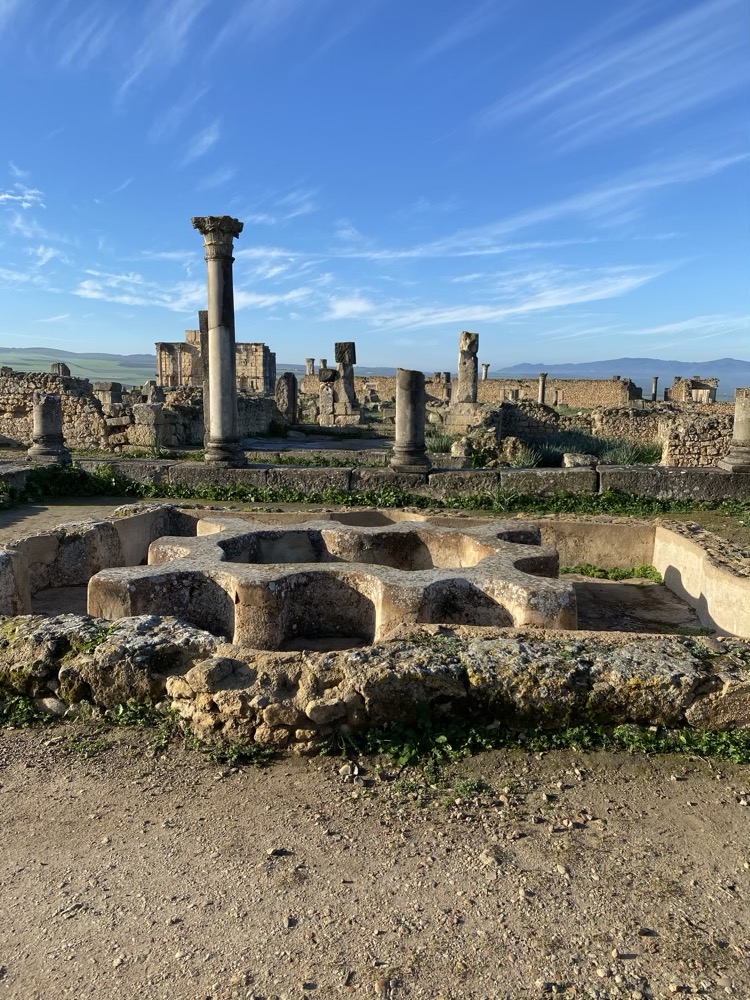 So many gorgeously preserved mosaics – I don’t think I’ve seen anything this impressive since Ephesus.
So many gorgeously preserved mosaics – I don’t think I’ve seen anything this impressive since Ephesus.
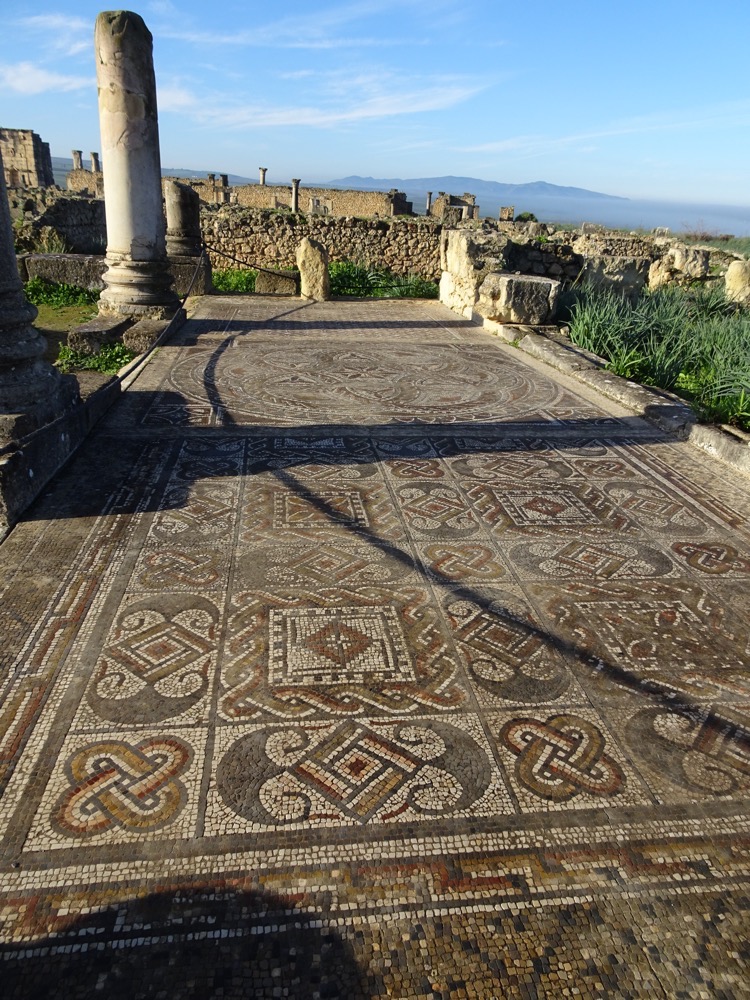 The Four Seasons depicted in the floors of the House of Hercules.
The Four Seasons depicted in the floors of the House of Hercules. 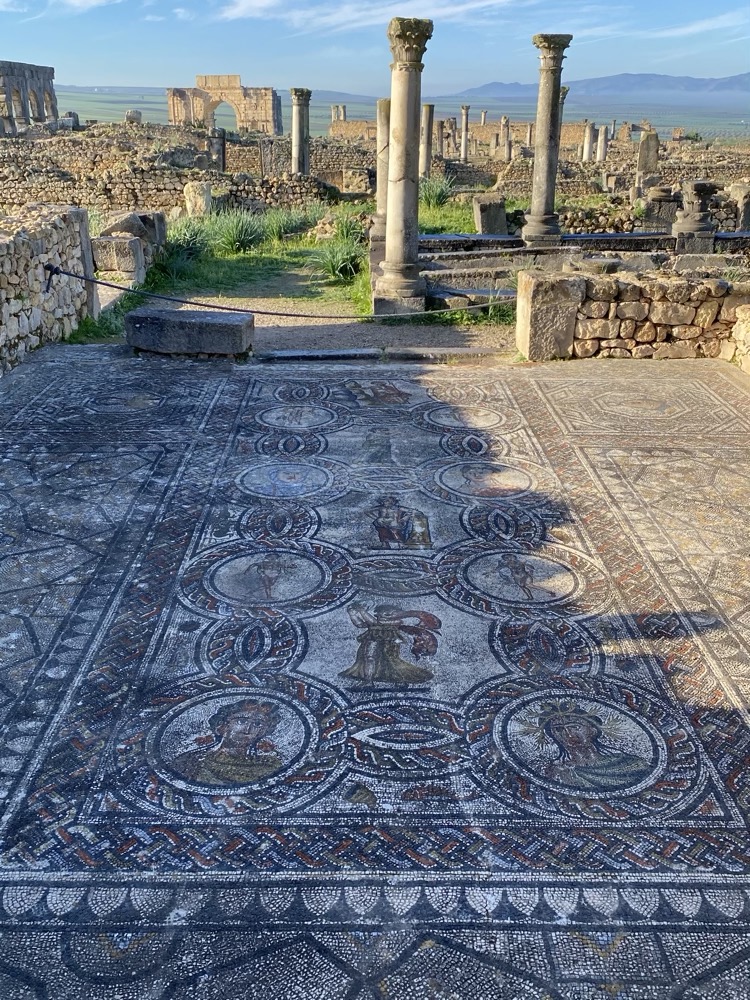

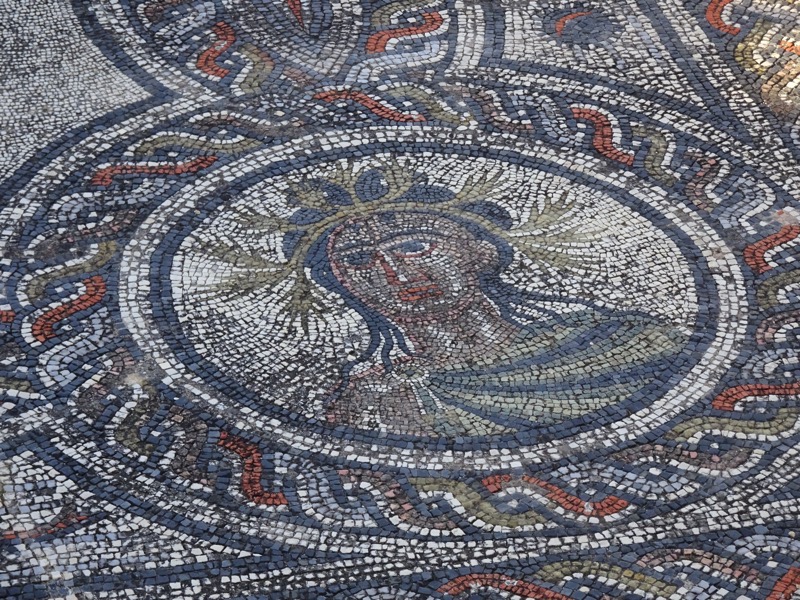
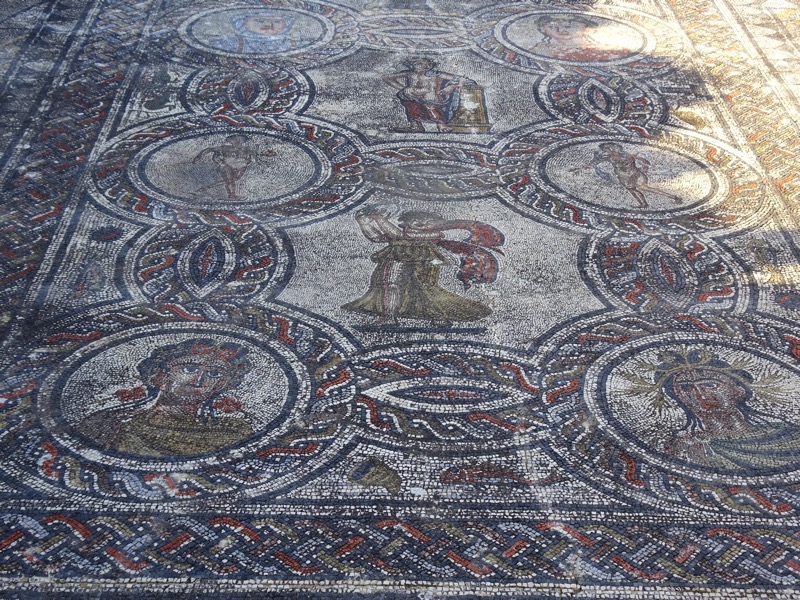 The Decumanus Maximus, looking south-west
The Decumanus Maximus, looking south-west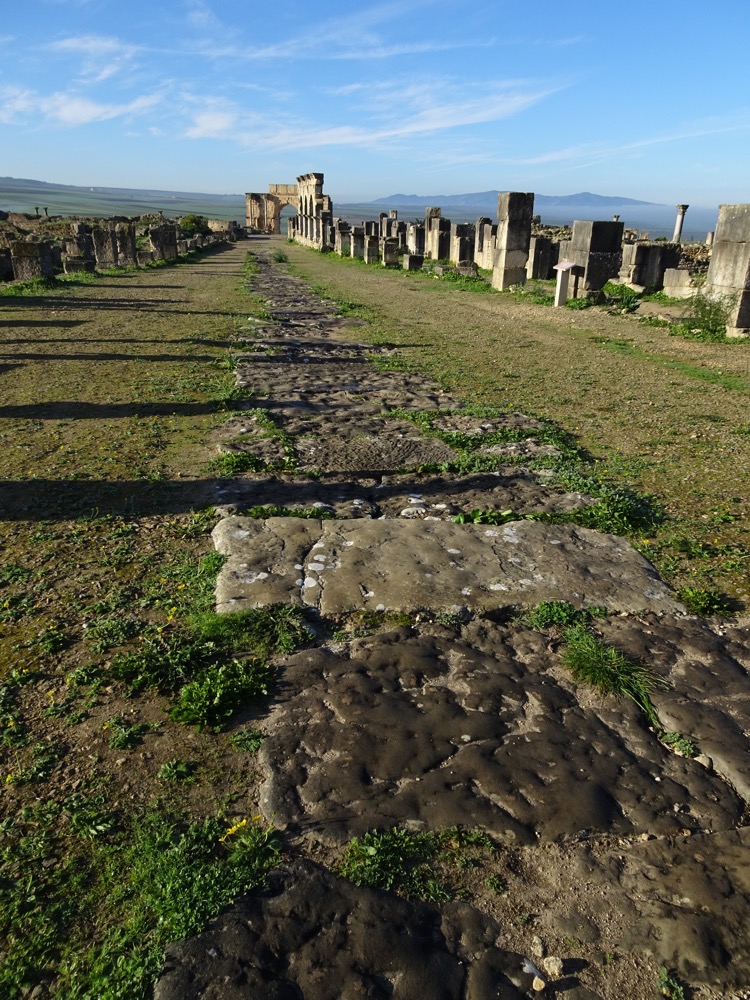
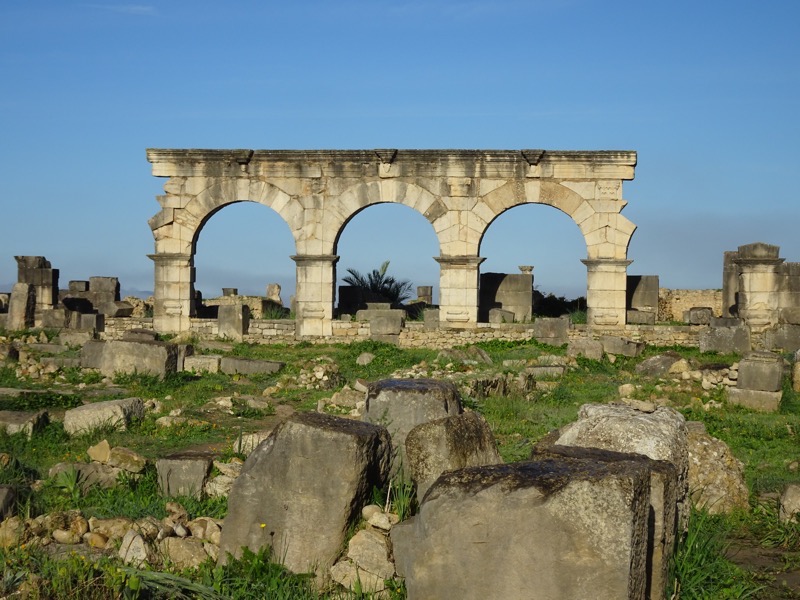 Attached to the site is a relatively new interpretive centre with some artefacts that were found on the site. Unfortunately, much of the site’s treasures have landed in the various museums of Europe, but there were some interesting objects housed here, including these steles from the Mauritanian to the Roman period. A stele was a small monument which depicts a character in relief or engraved often showing offerings in their hands.
Attached to the site is a relatively new interpretive centre with some artefacts that were found on the site. Unfortunately, much of the site’s treasures have landed in the various museums of Europe, but there were some interesting objects housed here, including these steles from the Mauritanian to the Roman period. A stele was a small monument which depicts a character in relief or engraved often showing offerings in their hands. 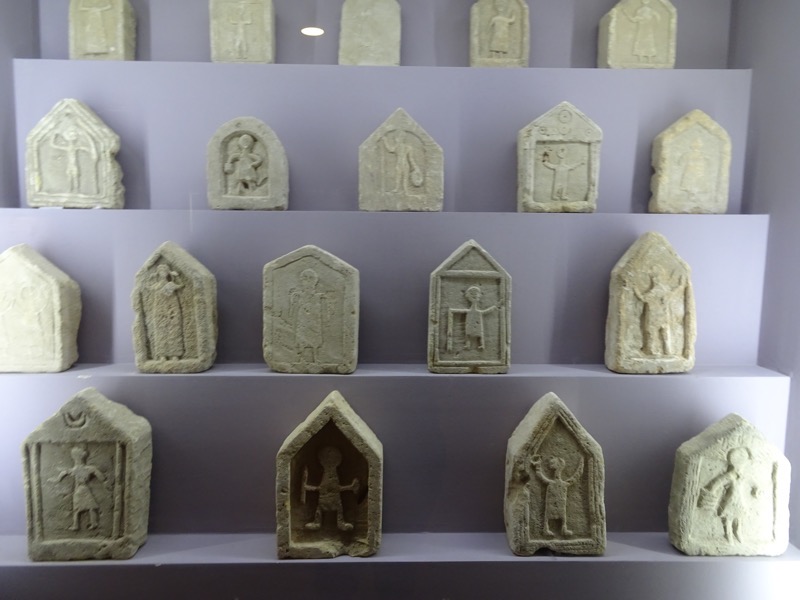
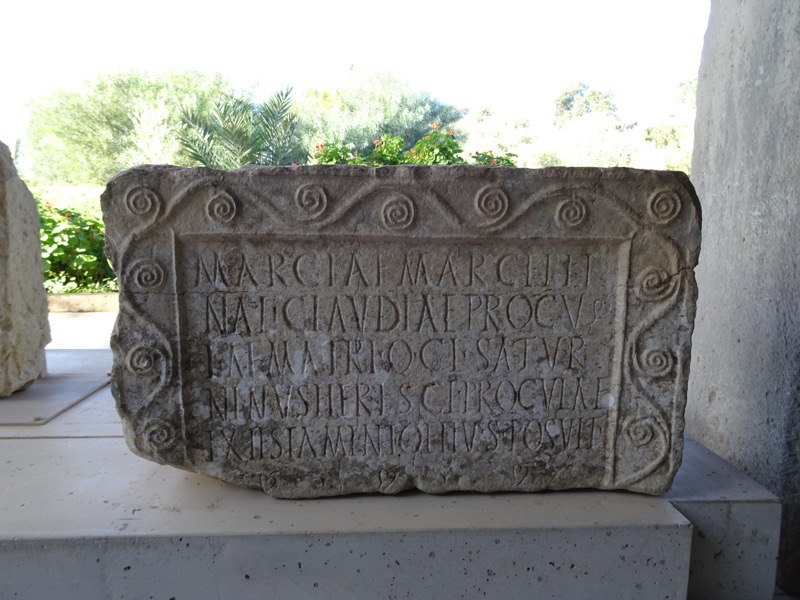
We had an amazing and very impressive visit to Volubulis, even if our guide was playing it pretty fast and loose with the classical history to keep the group entertained, and to have a site like that all to yourself for a couple of hours is simply wonderful… there were about three full-sized (50 peoples) tour buses pulling up as we were leaving.
After our visit to the ruins, we piled into some local transport and head for Meknes. Meknes was originally built as a military settlement and is a large walled city known for its imperial past. In the 17thC Sultan Moulay Ismail designed it as his capital and turned it into quite an impressive city. The city is predominantly Spanish-Moorish (?) in design and it has an unusual blend of Islamic and European architecture including enormous courtyards and its famed, elaborately decorated gates.
The Dar El Makhzen Royal Palace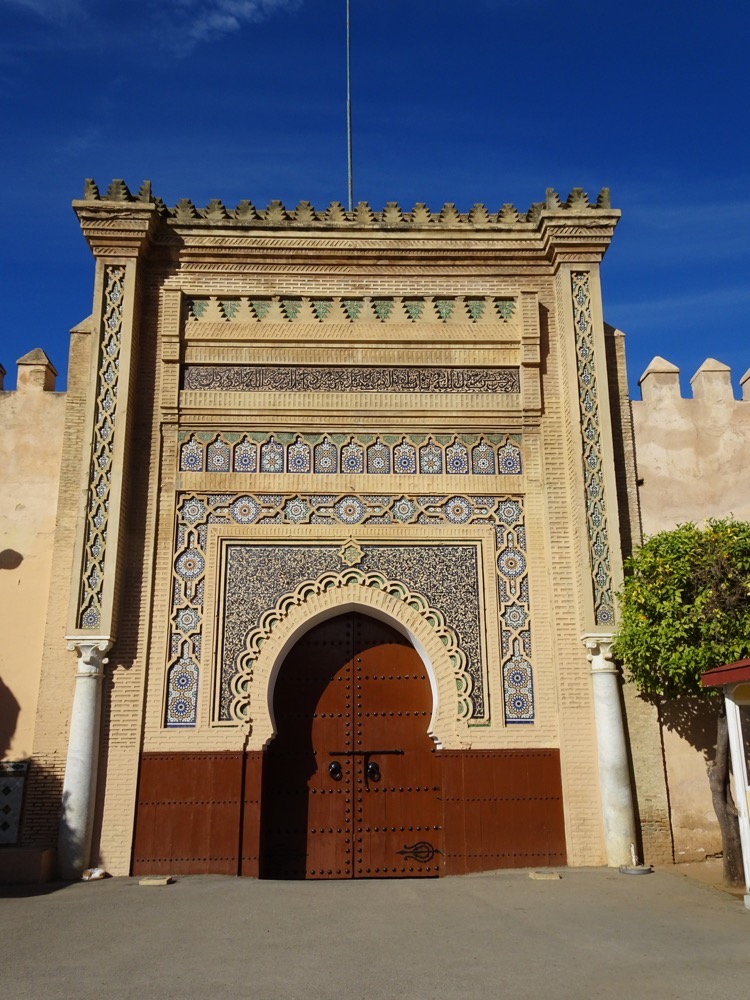 The Royal Palace still belongs to the current royal family and is not open to visitors. Inside we believe there are lavish buildings and a golf course for the King and his visitors.
The Royal Palace still belongs to the current royal family and is not open to visitors. Inside we believe there are lavish buildings and a golf course for the King and his visitors.
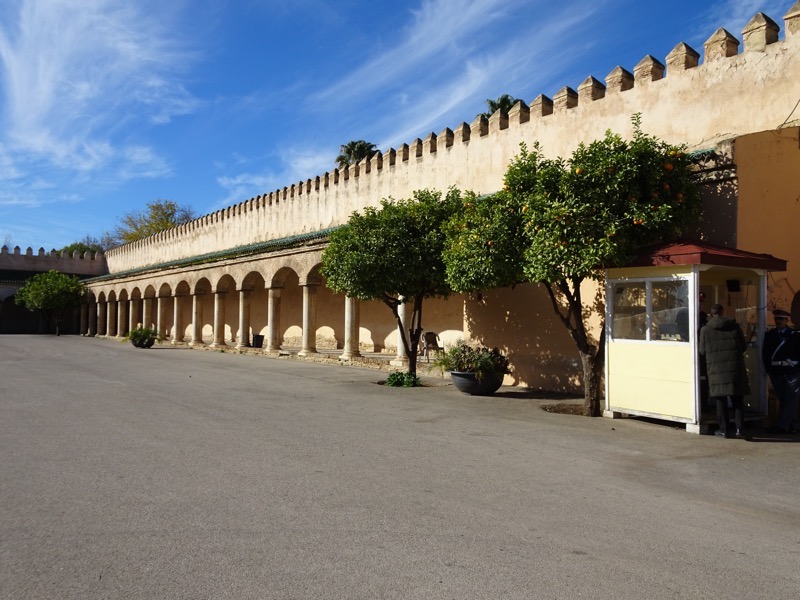 Outside, rows of palms and Seville orange trees…
Outside, rows of palms and Seville orange trees…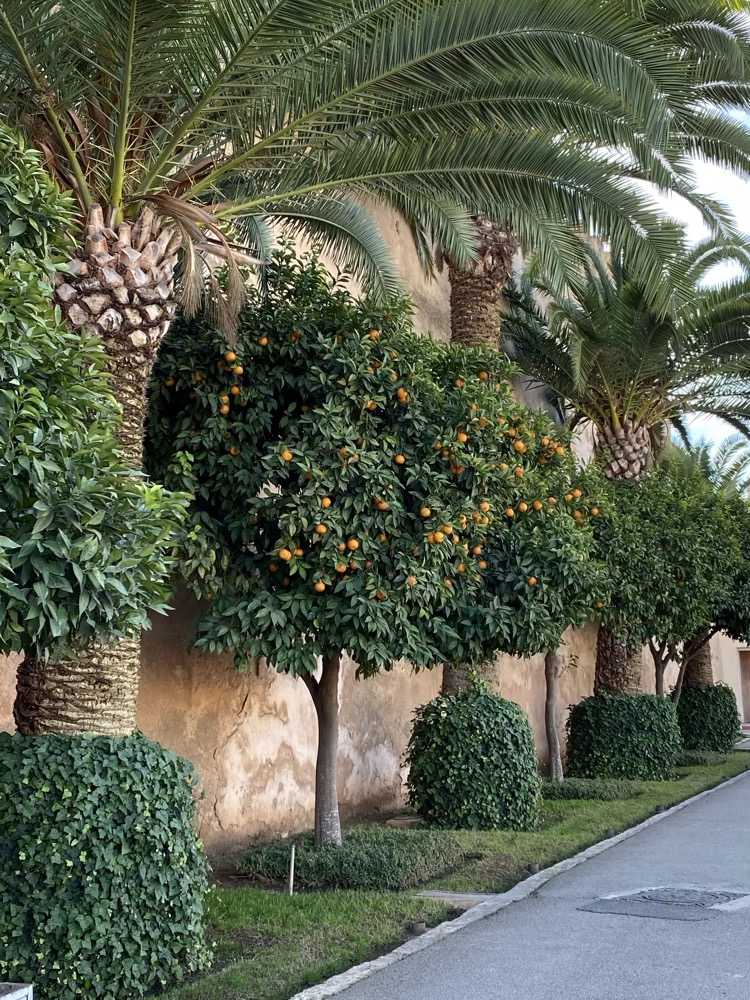
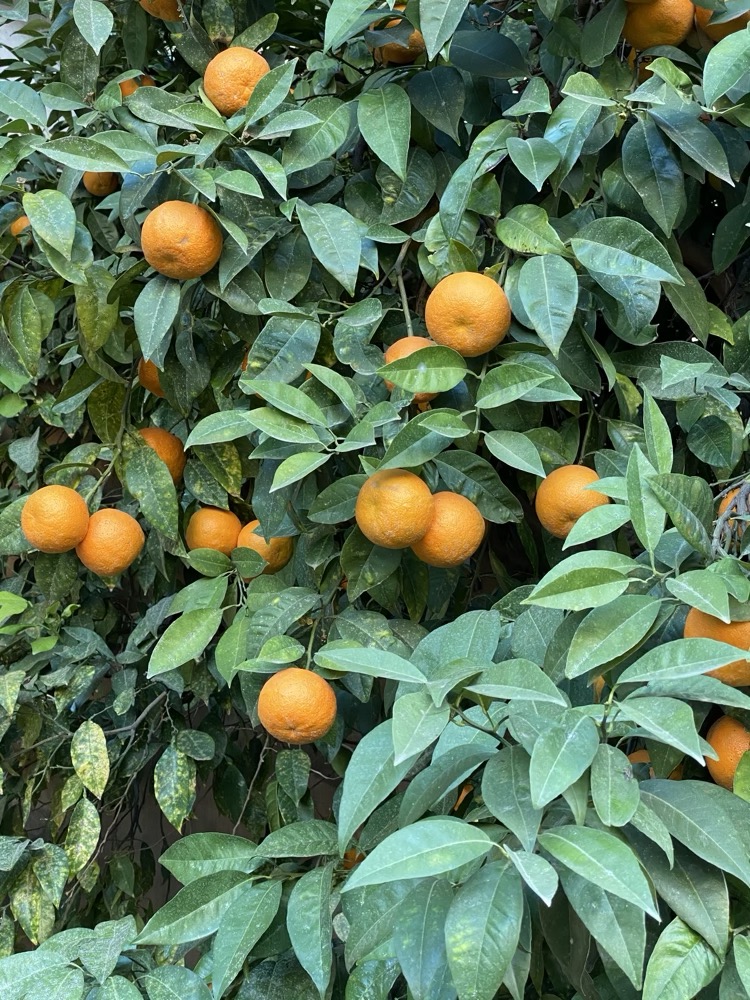
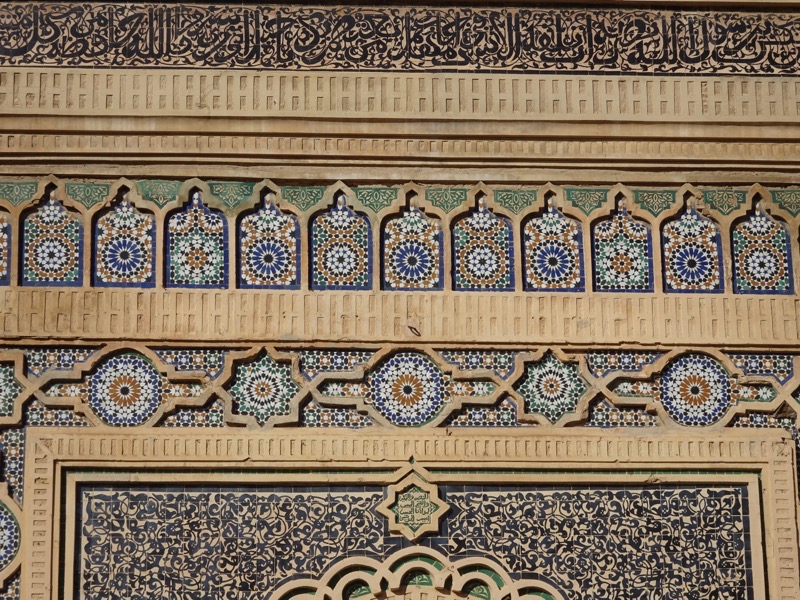 A modern monument celebrating the water bearers who wear the funny outfits.
A modern monument celebrating the water bearers who wear the funny outfits.
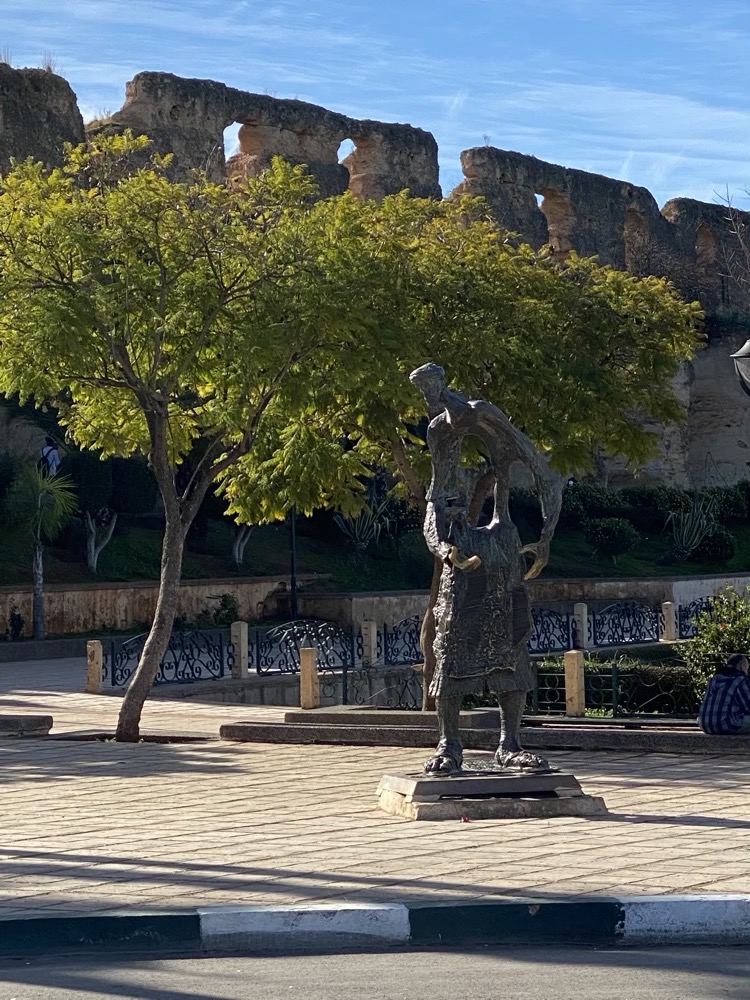
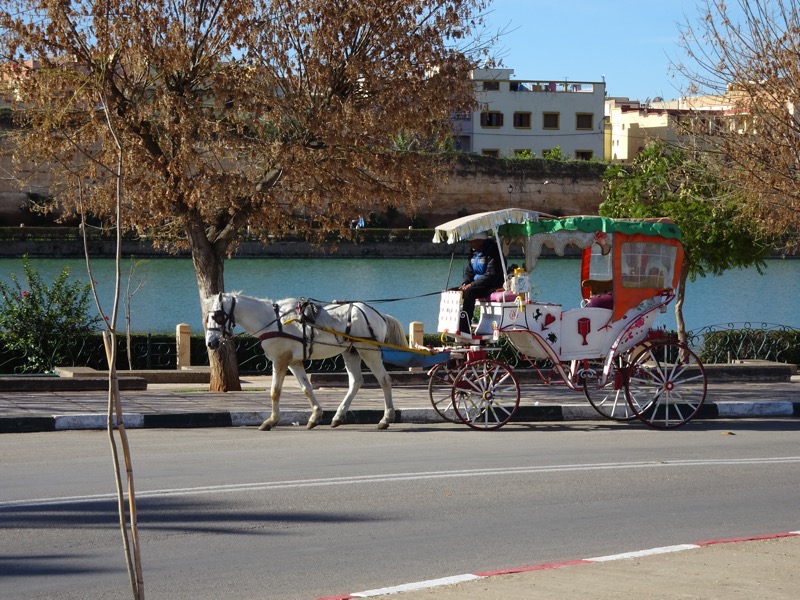 The Sahrij Swani – enormous granaries and stables that were built to support the military – the stables used to house some 3000 horses at the height of the Alaouite dynasty.
The Sahrij Swani – enormous granaries and stables that were built to support the military – the stables used to house some 3000 horses at the height of the Alaouite dynasty.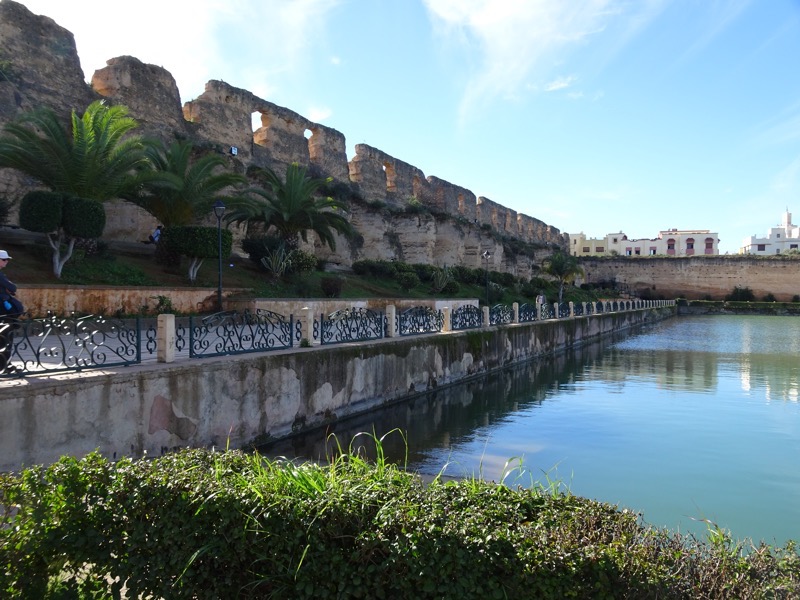 The Bab El Khemis Gate Built in 1693, near the Riad and Mellah quarters – we saw a heavily overloaded truck speed through this gate. It barely scraped through, we all did a sharp intake of breath as it screamed towards it. Whoever packed up that truck was obviously very familiar with the size of the gate!
The Bab El Khemis Gate Built in 1693, near the Riad and Mellah quarters – we saw a heavily overloaded truck speed through this gate. It barely scraped through, we all did a sharp intake of breath as it screamed towards it. Whoever packed up that truck was obviously very familiar with the size of the gate! 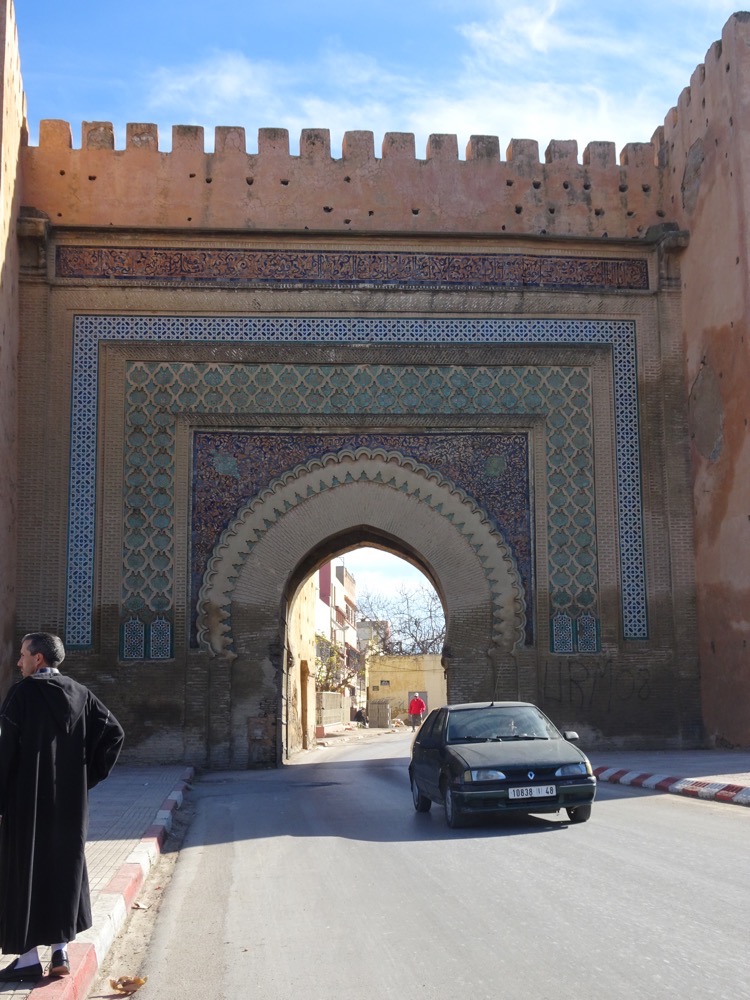 The very famous Bab El-Mansour gate, covered in mosaics, tile work and koranic inscriptions – built in 1732.
The very famous Bab El-Mansour gate, covered in mosaics, tile work and koranic inscriptions – built in 1732.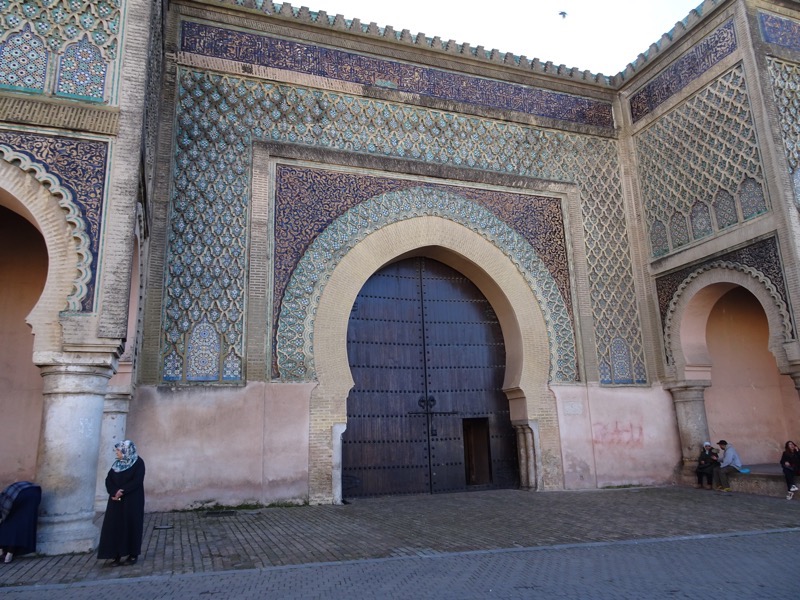 The history of the gate tells us that on completion of the gate when the Sultan inspected it, he asked the architect El-Mansour if he could do better, El-Mansour felt compelled to say ‘yes’, probably anticipating another commission. Instead, the Sultan was infuriated and had El-Mansour immediately executed.
The history of the gate tells us that on completion of the gate when the Sultan inspected it, he asked the architect El-Mansour if he could do better, El-Mansour felt compelled to say ‘yes’, probably anticipating another commission. Instead, the Sultan was infuriated and had El-Mansour immediately executed.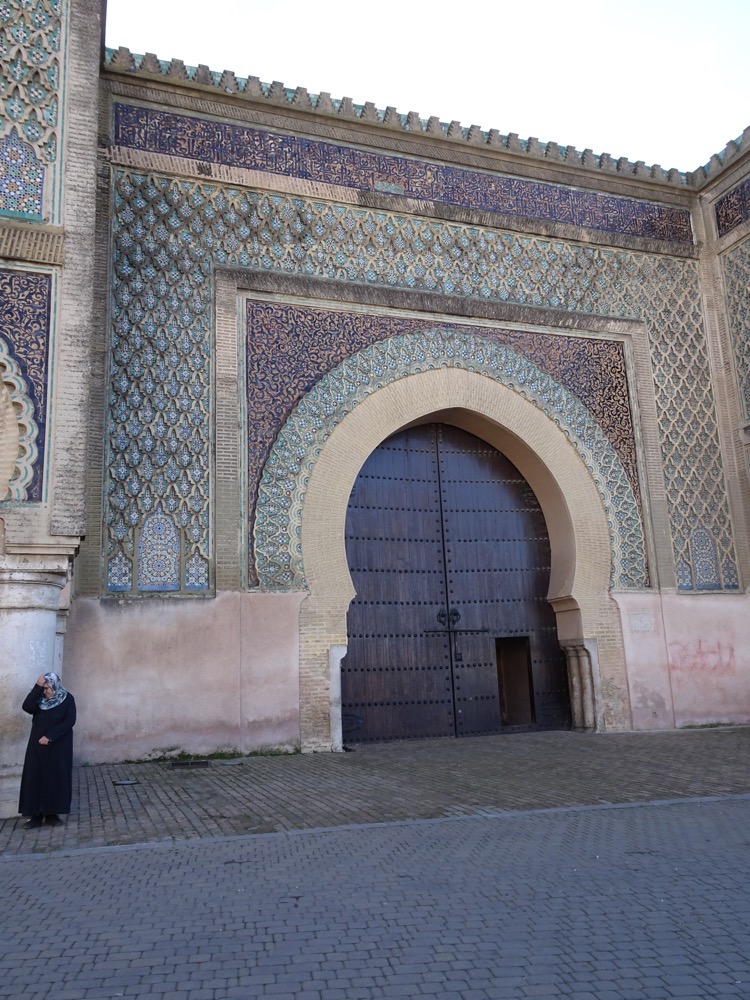
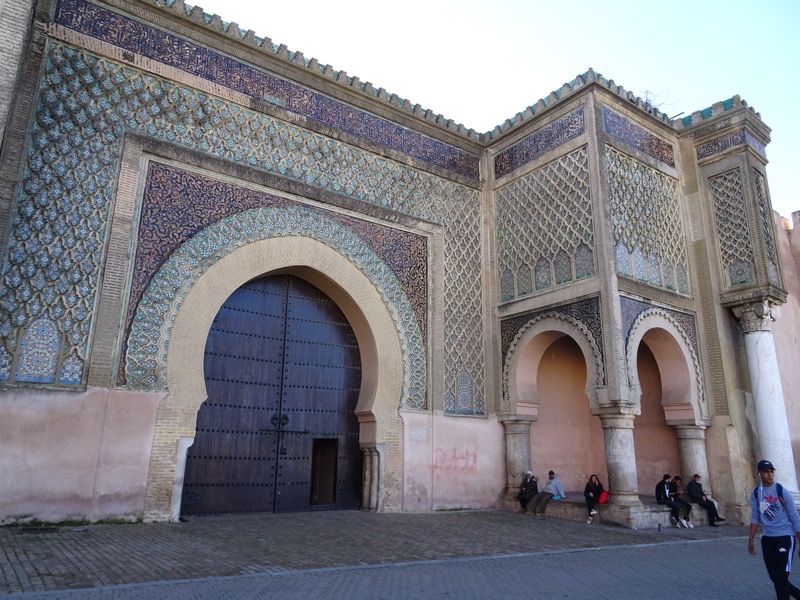
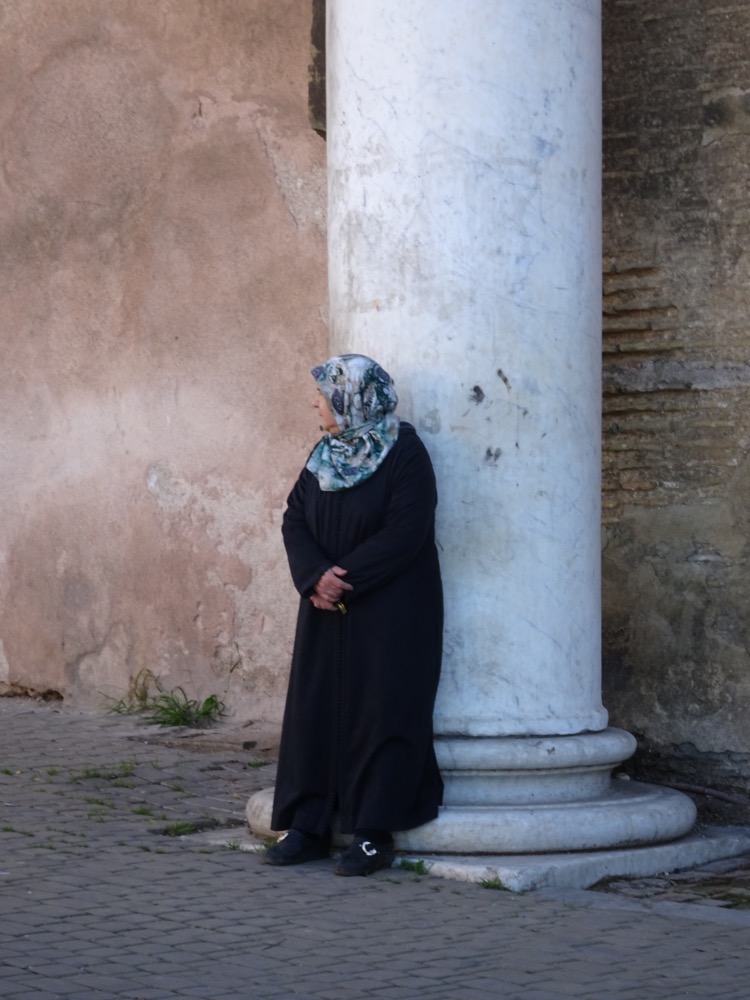 While I love the weird integration of Islamic and Roman elements in the design – it was less than impressive to learn that the columns were pilfered from Volubilis.
While I love the weird integration of Islamic and Roman elements in the design – it was less than impressive to learn that the columns were pilfered from Volubilis. 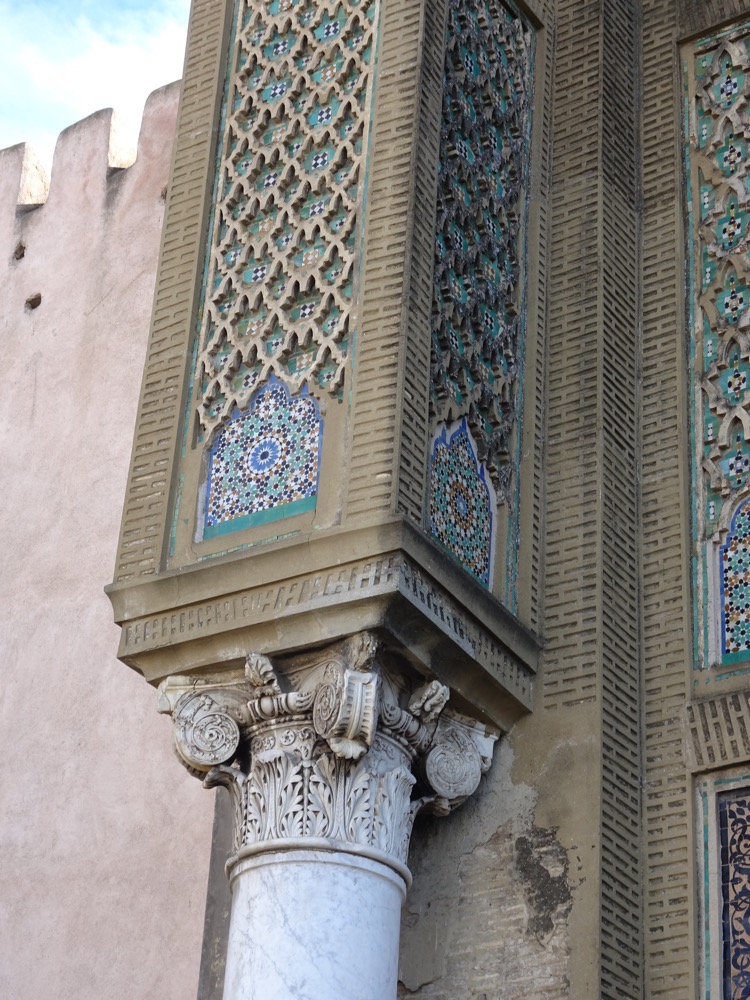 Across the road from the gate is an enormous town square – currently occupied by snake charmers (yes, actual snake charmers, though I don’t think they were very good – their snakes were mostly just laying around in the sun), and men with little monkeys on chains dressed in soccer team shirts that they were literally throwing onto hapless tourists to take photos with, so they could then demand money from the unsuspecting visitors. Most of our group is very well travelled and didn’t fall for this nonsense. Poor little monkeys. 🙁
Across the road from the gate is an enormous town square – currently occupied by snake charmers (yes, actual snake charmers, though I don’t think they were very good – their snakes were mostly just laying around in the sun), and men with little monkeys on chains dressed in soccer team shirts that they were literally throwing onto hapless tourists to take photos with, so they could then demand money from the unsuspecting visitors. Most of our group is very well travelled and didn’t fall for this nonsense. Poor little monkeys. 🙁 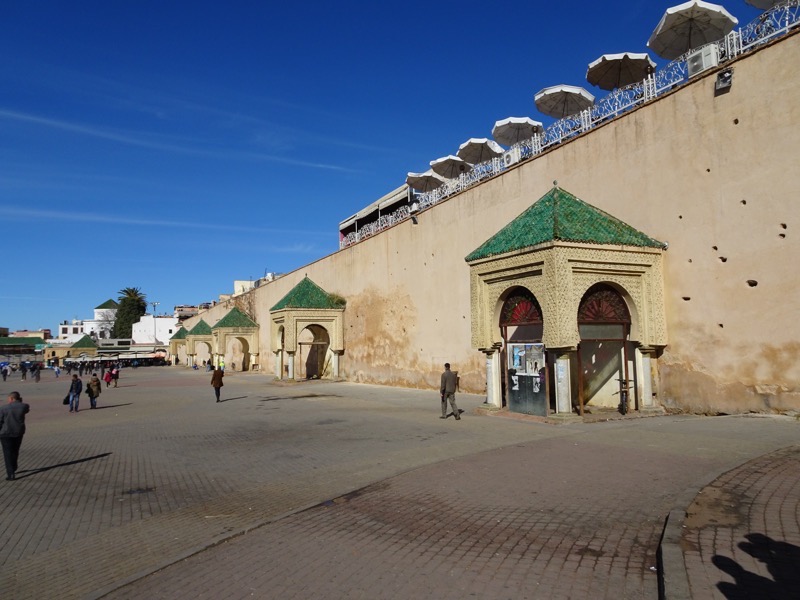 Surrounding the square was an endless row of restaurants and people selling tiles and ceramics and all sorts. The green-roofed doorway to right of this picture was the entrance to the undercover food market, which was full of shops selling spices, dates, figs, olives, pickles and down the smelly end – unrefrigerated meat.
Surrounding the square was an endless row of restaurants and people selling tiles and ceramics and all sorts. The green-roofed doorway to right of this picture was the entrance to the undercover food market, which was full of shops selling spices, dates, figs, olives, pickles and down the smelly end – unrefrigerated meat.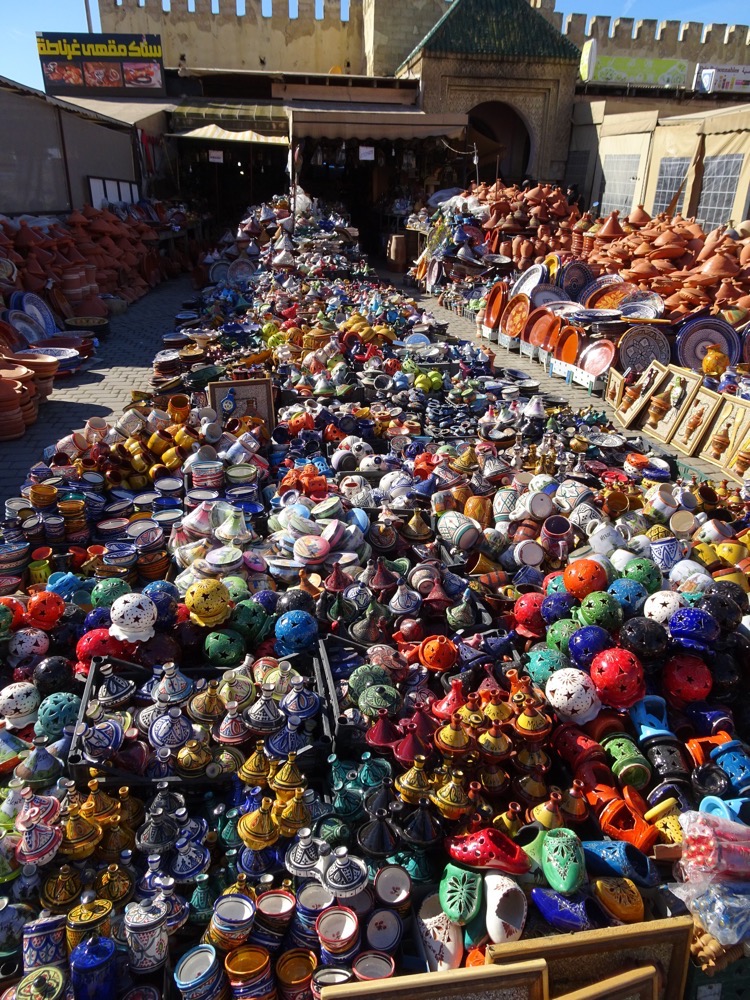
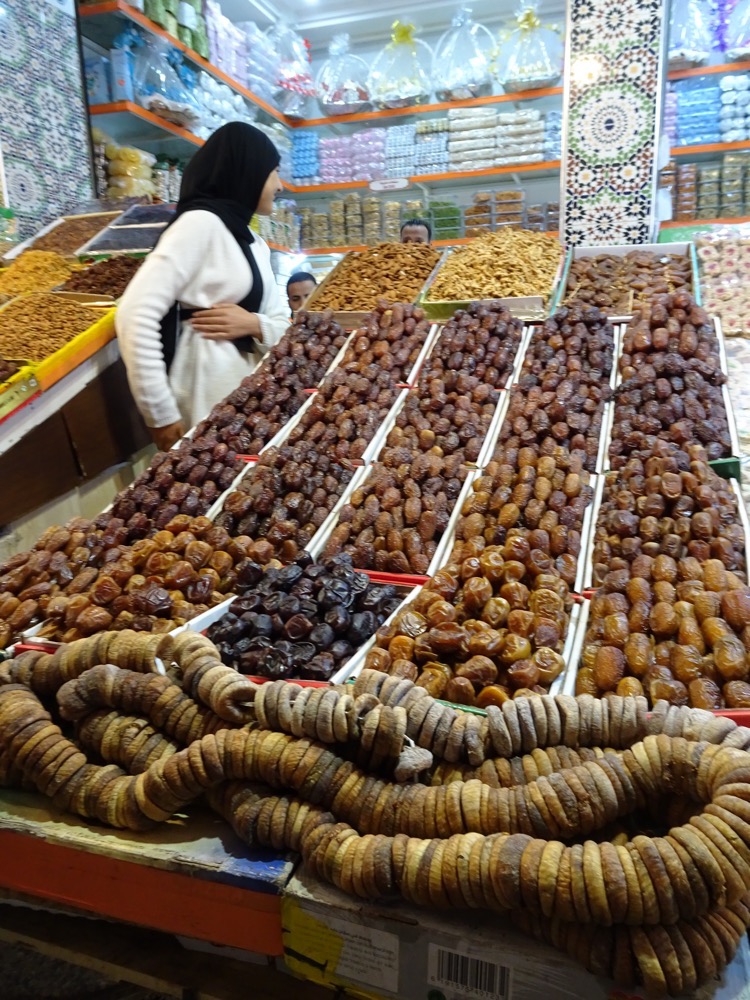 Olives, olives and more olives.
Olives, olives and more olives.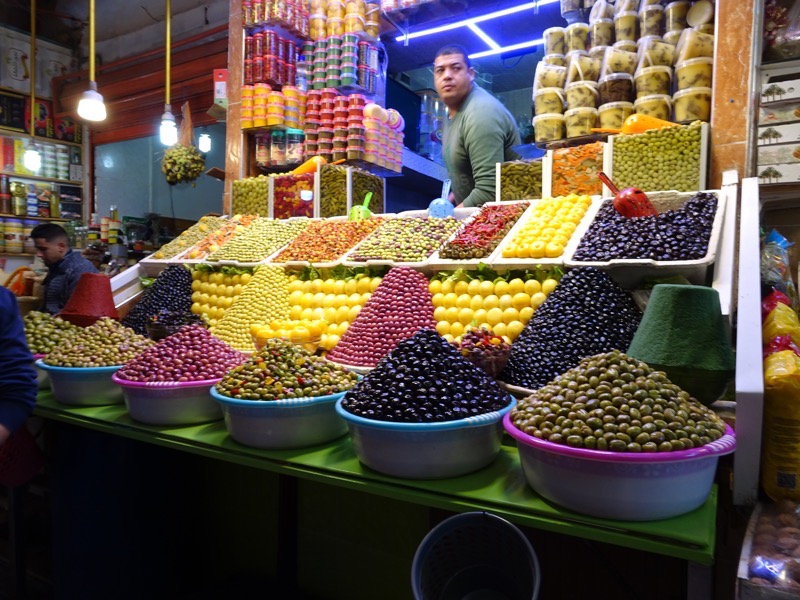 Across the other side of the square, away from the food markets was a maze of little alleyways that were more focused on the textile industries – stores full of silk, braids, garments, and garish fabric. You could hear the busy clatter of old embroidery machines around every corner.
Across the other side of the square, away from the food markets was a maze of little alleyways that were more focused on the textile industries – stores full of silk, braids, garments, and garish fabric. You could hear the busy clatter of old embroidery machines around every corner. 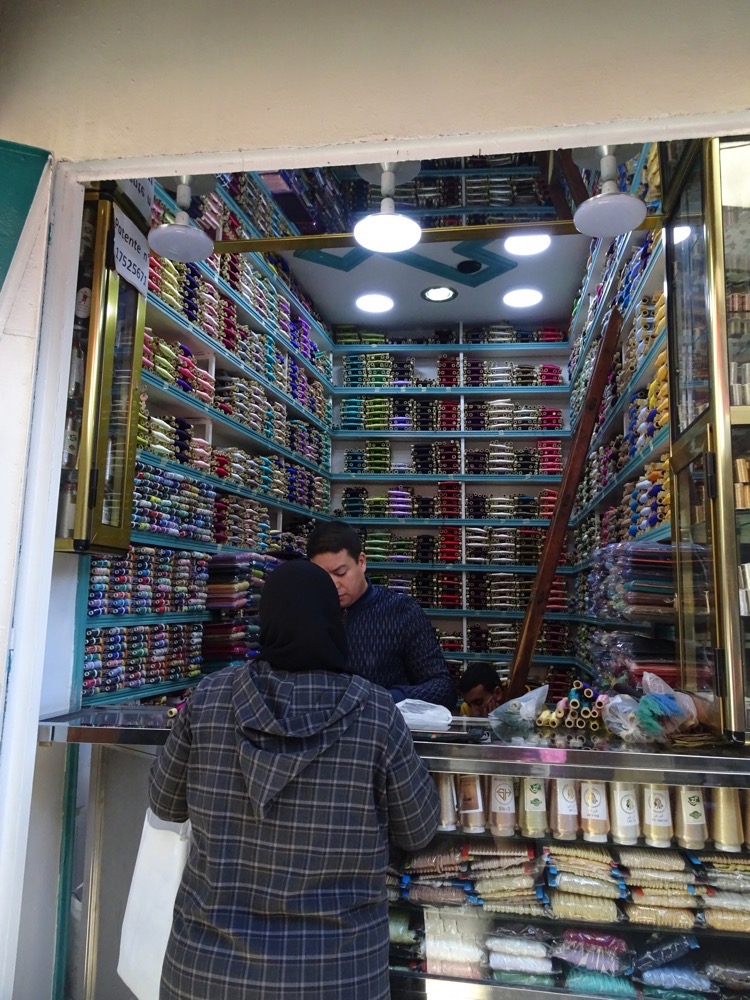
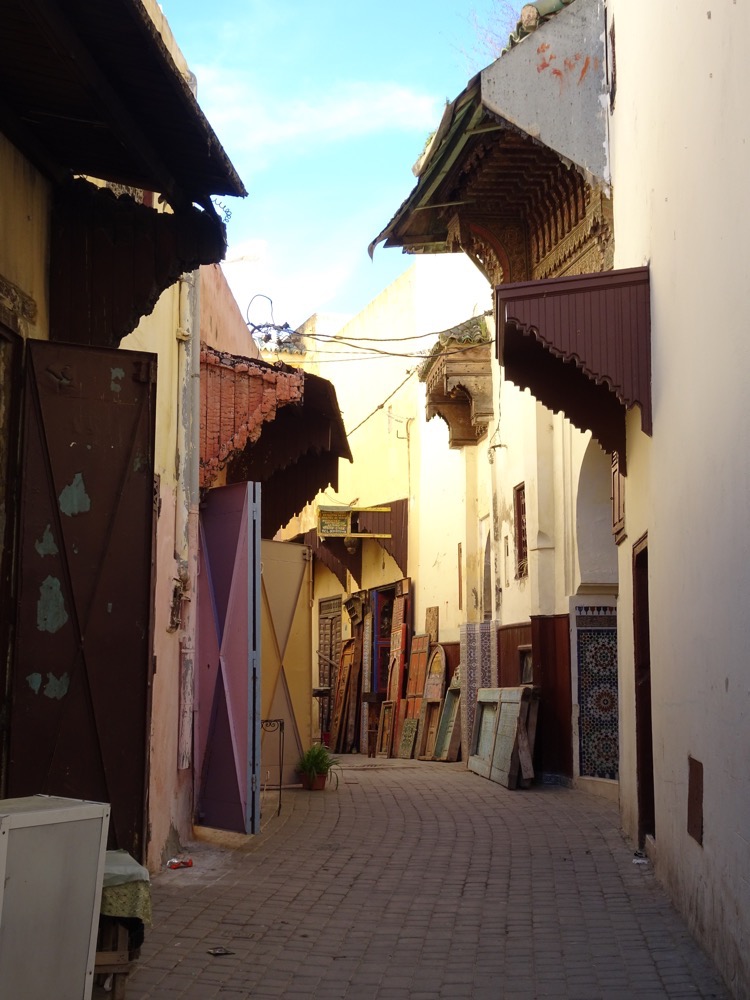
We wound our way through the alleys to our designated lunch spot to try a camel burger… honestly, the camel was tasty, but the way it was prepared it could have been lamb (or horse or donkey) for all we knew! It was made into squashed meatballs that had been simmered in some sort of tomato/onion something or other. Very tasty but not particularly distinctive. 
After lunch, we made our way back to the train station to catch a train to Fez. Catching trains here has been a bit fun. Samirr has been buying us tickets with allocated seating, but each time we get on the trains (juggling our luggage as we go) we have found ourselves fronting up to our seats and there are locals sitting in them. It seems the habit here is to buy a 3rd class ticket – no seating – and then go find yourself a seat in the 2nd class carriages and hope for the best. Some move immediately with good grace as soon as you turn up and say ‘excuse me, that is my seat’ and brandish your ticket, and others like today will just flatly refuse to ‘understand’ you. After a long day walking around and with an hour stuck on the train to Fez, none of us wanted to end up standing in the aisle. C’est la vie. We eventually made it to Fez with only one crotchety old dude sitting in among our group who refused to budge from the seat he hadn’t paid for.
We made it to our hotel – the tautological, Hotel Fez Inn. Which is quite a lovely and well-appointed place and it has… *drumroll please*… a BAR! Needless to say almost as soon as people had squared away their stuff and had a quick shower, we were all down in the bar settled with a drink.
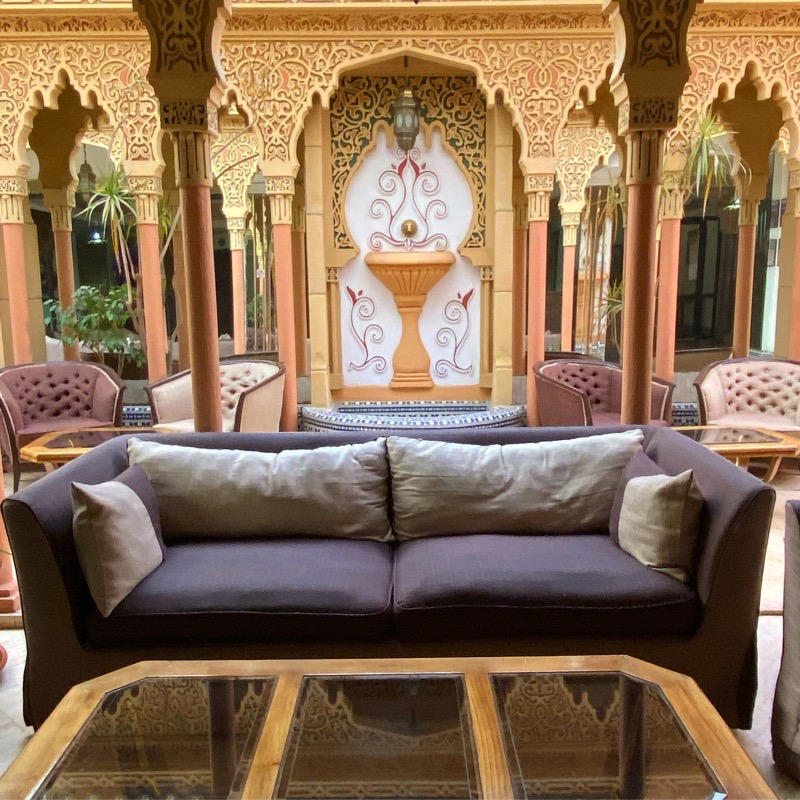 Whereupon, it became rapidly apparent that the group was… err, apprehensive about the restaurant we were headed to that night. Intrepid runs several different styles of trip – Comfort – Basic – Physical and Family trips. And our fearless leader seemed to be leading us to what we could call, ‘TOURIST RESTAURANTS’. After such a lovely and authentic meal at the guesthouse last night, the last thing everyone wanted was to find themselves at another overpriced tourist restaurant with bland ordinary food. So… the peasants (that’s us) decided to revolt. I popped upstairs to change my shoes and grab my handbag and pretty much expected when I came back down that the group’s desire for a more authentic Moroccan dining experience would have been communicated to Samirr.
Whereupon, it became rapidly apparent that the group was… err, apprehensive about the restaurant we were headed to that night. Intrepid runs several different styles of trip – Comfort – Basic – Physical and Family trips. And our fearless leader seemed to be leading us to what we could call, ‘TOURIST RESTAURANTS’. After such a lovely and authentic meal at the guesthouse last night, the last thing everyone wanted was to find themselves at another overpriced tourist restaurant with bland ordinary food. So… the peasants (that’s us) decided to revolt. I popped upstairs to change my shoes and grab my handbag and pretty much expected when I came back down that the group’s desire for a more authentic Moroccan dining experience would have been communicated to Samirr.
Instead, Mr K and I came back down to the bar and everyone was sitting around making niceties, Samirr was in the seat I had vacated, and I walked in and said, ‘What’s the plan?’ Three people answered, ‘Oh, we were waiting for you.’ Le sigh… So I got to be the grown-up in the room and explain to Samirr that we had really loved the guesthouse but we weren’t keen on another tourist restaurant for dinner. Samirr was somewhat perturbed (I think his kickback just went out the window) but we really didn’t want to go another place where you pay 100DH for a bland and spiceless tagine dish, 80DH for a salad and 24DH for a Coke Zero, when a local restaurant would offer you something super tasty and spicy for 30DH, 20DH and 8DH respectively.
Ever the professional, Samirr rapidly adjusted the schedule and took us to a ‘meat place’. Where we all stuffed ourselves on delicious eggplant, spinach dishes, and really tasty grilled chicken, koftas and drumsticks… the restaurant was full of locals – always a good sign – and the owner shoved us in the very back of the restaurant (I think so the visuals of a bunch of tourists eating in his place wouldn’t keep the locals away!).
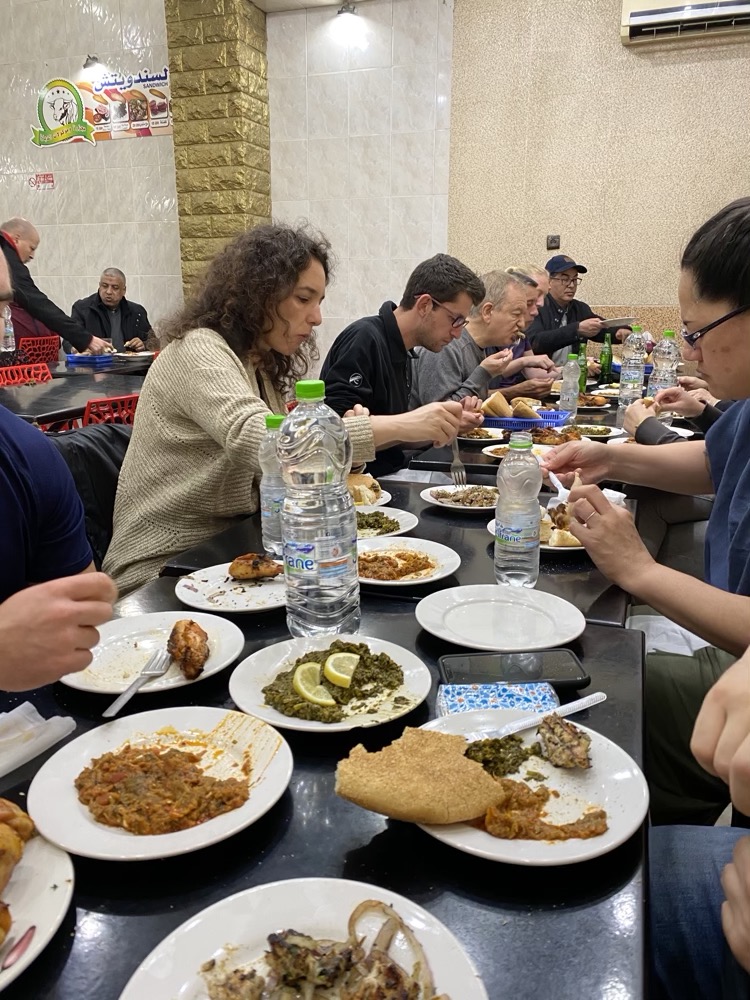 All up, a very tasty meal with some unsual offerings, which, including drinks and tips, it came to a grand total of 55DH per person compared to the 120DH per person at the first tourist restaurant… but someone else can have the next conversation with Samirr when the group wants to change the plan!
All up, a very tasty meal with some unsual offerings, which, including drinks and tips, it came to a grand total of 55DH per person compared to the 120DH per person at the first tourist restaurant… but someone else can have the next conversation with Samirr when the group wants to change the plan!
*nothing to do with anything, but on our way back from the restaurant, there was a god awful stench, and I happened to look down into a basement under an apartment building and see a chicken farm… urgh! People were living right upstairs from this, but at least they could buy fresh eggs right on the spot. 😐  !
!
